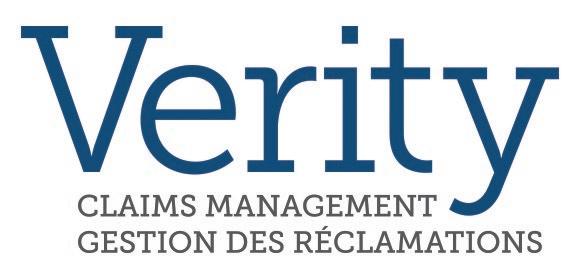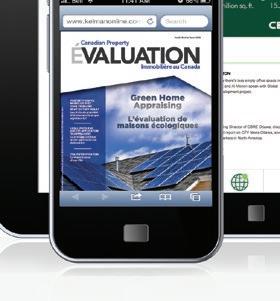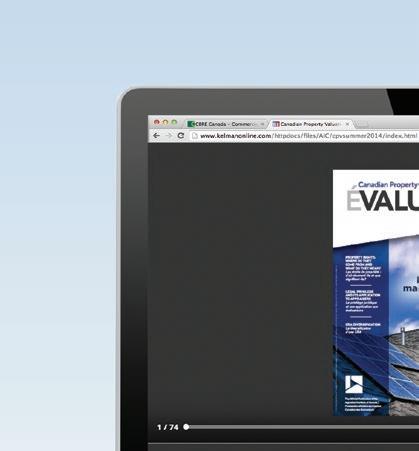Canadian Property






























AIC PRESIDENT: CAREER SUCCESS BUILT ON PASSION Présidente de l'ICE : La réussite professionnelle fondée sur la passion

Immobilière au Canada
NAVIGATING INTELLIGENT
































WATER SYSTEMS: HEALTH, SAFETY, AND RISK MITIGATION Utilisation des réseaux d’alimentation en eau intelligents : santé, sécurité et réduction des risques ARBITRATING ‘FAIR MARKET RENTAL’ IN COMMERCIAL RENT REVIEWS Arbitrage du « juste loyer marchand » dans les examens de location commerciale L’INTUITION et son rôle




Appraisal Institute of Canada

Publication officielle de l'Institut canadien des évaluateurs
INTUITION and its role in the Direct Comparison Approach

Vol 66 | Book 4 / Tome 4 | 2022 PM #40008249 Return undeliverable Canadian Items to: Appraisal Institute of Canada, 403-200 Catherine St., Ottawa, ON K2P 2K9 The Official
Publication of the
/
2022-23
dans la méthode de comparaison directe






























For more information, please contact: Dave Black AACI, P.App, MRICS Executive Vice President & National Practice Lead JLL Valuation Advisory Dave.Black@am.jll.com jll.ca/value
Be the expert
Colliers is seeking motivated appraisers to join our Valuation and Advisory Services team.

Colliers recently introduced new market leading report writing software which upon its introduction increased average report production speeds by upwards of 30%. Colliers AACI designated appraisers in Canada had an average net compensation in 2021 in excess of $382,000. Reach out today to learn how to leverage Colliers brand, technology and resources to take your career to the next level.




Contact Lisa McAteer at L Lisa.M McAteer@colliers.com to learn more about joining Valuation & Advisory Services at Colliers International.
colliers.com
Suzanne de Jong: Career success built on passion
Suzanne de Jong : La réussite professionnelle fondée sur la passion

Intuition and its role in the Direct Comparison Approach L’intuition et son rôle dans la méthode de comparaison directe





Navigating intelligent water systems: health, safety, and risk mitigation Utilisation des réseaux d’alimentation en eau intelligents : santé, sécurité et réduction des risques
COLUMNS CHRONIQUES
Le coin de l'exécutif Présidente de l'ICE 2022-23 : La réussite professionnelle fondée sur la passion
Questions juridiques Arbitrage du « juste loyer marchand » dans les examens de location commerciale
Défense des intérêts Mémoire pour la consultation pré-budgétaire en prévision du budget fédéral
Nouvelles • Réservez cette date : Le Congrès national 2023 de l’ICE • Dates importantes • En mémoire • Gagnants du concours de photos 2022
The articles printed in this issue represent authors’ opinions only and are not necessarily endorsed by the Appraisal Institute of Canada Copyright 2022 by the Appraisal Institute of Canada All rights reserved. Reproduction in whole or in part without written permission is strictly prohibited.
Subscription, $40.00 per year. Printed in Canada.
Les articles imprimés dans ce numéro ne repésentent que l’opinion de leur auteur respectif, mais ne sont pas nécessairement endossés par l'Institut canadien des évaluateurs Tous droits reservés 2022 par l'Institut canadien des évaluateurs. La reproduction totale ou partielle sous quelque forme que se soit sans authorisation écrite est absolument interdite. Abonnement 40,00 $ par année. Imprimé au Canada.
* The Appraisal Institute of Canada reserves the right to reject advertising that it deems to be inappropriate.
** The publisher and the Appraisal Institute of Canada cannot be held liable for any material used or claims made in advertising included in this publication.Indexed in the Canadian Business Index and available on-line in the Canadian Business & Current Affairs database. ISSN 0827-2697
Publication Mails Agreement #40008249
Return undeliverable Canadian items to: Appraisal Institute of Canada 403-200 Catherine St., Ottawa, ON K2P 2K9.
Manager, Communications: Haddy John, Ottawa
Publication management, design and production by: Direction, conception et production par :
3rd Floor – 2020 Portage Avenue, Winnipeg, MB R3J 0K4
Phone: 866-985-9780 Fax: 866-985-9799 E-mail: info@kelman.ca Web: www.kelman.ca
Managing Editor: Craig Kelman
Design/Layout: Jackie Magat
Marketing Manager: Kris Fillion
Advertising Co-ordinator: Stefanie Hagidiakow
9 Executive Corner 2022-23 AIC
on
38 Legal Matters Arbitrating
commercial rent
46 Advocacy Submission for the pre-budget consultation in advance of the 2023 Federal Budget 52 News • Save the Date: 2023 AIC National Conference • Important Dates • In Memoriam • 2022 Photo Contest winners 54 Designations, Candidates, Students
42
President: Career success built
passion
‘fair market rental’ in
reviews
14
49
52
54 Désignations, stagiaires, étudiants
9
30 18
SAVE THE DATE!
It's time to start preparing for your trip to Vancouver, British Columbia!



AIC's 2023 Conference Committee has been hard at work planning another dynamic and memorable conference experience. Join us in this bustling west coast seaport from May 31 to June 3, 2023. Reconnect with colleagues from across Canada, connect with thought leaders and industry actors, earn CPD credits, and experience the best of what Vancouver has to offer!

AIC is excited to, again, host the national conference as a hybrid event this year; with both an immersive in-person experience and a virtual option for online/distance attendees.
For more details: https://www.aicanada.ca/aic-events/2023-annual-conference/
Le Congrès de l’ICE 2023 RÉSERVEZ


LA DATE !
C’est le temps de commencer à planifi er votre voyage à Vancouver, Colombie-Britannique !
Le comité du Congrès de l’ICE 2023 a travaillé fort pour mettre au point une expérience de congrès des plus dynamiques et mémorables. Soyez des nôtres au sein de ce port marin très animé de la côte ouest, du 31 mai au 3 juin 2023. Renouez avec des collègues et des chefs de fi le de l’industrie canadienne, faites de nouveaux contacts, gagnez des crédits de PPC et découvrez ce que Vancouver a de meilleur à offrir !
Encore une fois cette année, l’ICE est heureuse d’offrir un congrès sous forme d’événement hybride, avec une composante immersive en personne et une option virtuelle pour les participants en ligne/à distance.
Pour plus de détails, visitez le site web : https://www.aicanada.ca/ fr/evenements-aic/conference-annuelle-2023/
Canadian Property Valuation | Évaluation immobilière au Canada 6 Return to CONTENTS
2023 Conference
Keynote Speakers:

Opening Keynote: Zahra Al-Harazi Award-Winning Entrepreneur Purpose-Driven Leadership Expert

Considered among Canada’s most successful entrepreneurs, Al-Harazi helps people and organizations realize their potential for success by fi nding their purpose. She draws on her experience as a pioneering woman in the business world with a unique approach to attitude, leadership, and success, as well as her experience as a refugee, immigrant, entrepreneur, and community builder.


Keynote: David Chalk Technology Navigator




Artificial
Intelligence & Cybersecurity Expert
Dr. David Chalk is a realistic futurist with a 25-year track record of accurately predicting the interaction of humans and machines. Awarded a Doctorate Degree in technology by the University of the Fraser Valley, David presents what audiences need to know to succeed in business, technology and life. As an expert on technology and disruptive innovation, David has worked in artificial intelligence at the highest levels and can unconditionally confirm that humans will always triumph over machines
Les conférenciers principaux du Congrès 2023 :
Discours d’ouverture : Zahra Al-Harazi Entrepreneure primée Spécialiste en leadership engagée Considérée comme l'une des entrepreneures les plus accomplies au Canada, Zahra aide les gens et les organisations à réaliser leur potentiel de succès en trouvant leur raison d'être. Elle s'appuie sur son expérience comme femme pionnière dans le monde des affaires ayant une vision unique de l’attitude, du leadership et du succès, ainsi que sur son expérience en tant que réfugiée, immigrante, entrepreneure et bâtisseuse communautaire.
Discours : David Chalk Explorateur de technologies Expert en intelligence artificielle et en cybersécurité Dr. David Chalk est ce futuriste réaliste qui prédit avec exactitude depuis 25 ans l’interaction entre les êtres humains et les machines. Détenant un doctorat en technologie de la University of the Fraser Valley, David explique ce que le public doit savoir pour réussir dans les affaires, la technologie et la vie. À titre d’expert de la technologie et de l’innovation perturbatrice, David a travaillé aux plus hauts niveaux dans le domaine de l’intelligence artificielle et il peut confirmer sans réserve que le triomphe de l'humain sur la machine sera toujours assuré.
Volume 66 | Book 4 / Tome 4 | 2022 7 Return to CONTENTS
Looking for a career with purpose?


Share your expertise and appraise some of Canada’s most progressive agricultural, commercial and industrial assets.
Sound interesting? Reach out to Hugues Laverdure, FCC Senior Director, at hugues.laverdure@fcc.ca

Vous voulez donner un élan à votre carrière?
Mettez votre expertise à profit et évaluez certains des actifs agricoles, commerciaux et industriels les plus modernes au Canada.
Ça vous intéresse?

Communiquez avec Hugues Laverdure, premier directeur à FAC, par courriel à l’adresse hugues.laverdure@fac.ca

JOIN OUR NETWORK AND FIND OUT HOW WE ARE DIFFERENT






Not all service providers are the same. At FNF Canada, we are always looking to expand our APPRAISAL NETWORK.







Business Association of Real Estate Appraisers
Stronger together
DON’T GO IT ALONE
OUR VISION

To be the most trusted association of residential appraisal firms in Canada.
OUR MANDATE BAREA protects and promotes the business interests of our member firms through a strong and cohesive voice as well as the sharing of best practices.
For more information please visit: fnf.ca/products/appraisal-plus
Stronger together DON’T GO IT ALONE

OUR VISION
To be the most trusted association of residential appraisal firms in Canada.

OUR MANDATE BAREA protects and promotes the business interests of our member firms through a strong and cohesive voice as well as the sharing of best practices.
Business Association of Real Estate Appraisers barea.ca
8 Return to CONTENTS
Canadian Property Valuation | Évaluation immobilière au Canada
Career success built on passion

Whether in her personal life or her 32-year career in real estate appraisal, Suzanne de Jong possesses a genuine passion for everything in which she is involved. That passion has enabled her to be successful in all aspects of her life, including being recently elected the second female president in the 84-year history of the Appraisal Institute of Canada (AIC). Suzanne leads by example and is very much looking forward to the year ahead as the AIC continues to shape its future in an ever-changing marketplace.

Q:
























Suzanne: After growing up in Mississauga, I enrolled in the economics program at Western University in London, Ontario. One of the courses that genuinely interested me was entitled Urban
Development (UD). After graduating in 1989 with a degree in UD, at a time when the economy was truly booming, I initially thought I would go to work for a developer back in Toronto or Mississauga. However, having grown to love the London region, I was fortunate to connect with Bob Hughes who owned a small appraisal fi rm in London known as Hughes & Associates. Doing junior research, I dealt with a variety of legal issues including a case of litigation involving contaminants leeching into a campground. It was very fascinating work that whet my appetite for the incredible variety of real estate-related opportunities and challenges that an appraisal career offers. My career path was set. Wanting to specifi cally increase my experience with residential appraisal, which I believe is the ideal place to start an appraisal career, I subsequently joined the Simmons Group headed by
AIC’s 2022-23 President, Suzanne de Jong, AACI, P.App
EXECUTIVE CORNER
Can you elaborate on the career path that led to your current position?
9 Return to CONTENTS Volume 66 | Book 4 / Tome 4 | 2022
The appraisal field has given me amazing opportunities to grow my career while affording me great flexibility to spend time with my family and have a full life outside of work.
John Simmons. That company is now the Metrix Realty Group, and, although I actually left for a few years to try my hand elsewhere, I came back to experience and be part of the company’s outstanding team atmosphere.
As my career developed during these years, I married, now have four children, earned my CRA designation in 1993 and my AACI in 2003. The appraisal fi eld has given me amazing opportunities to grow my career while affording me considerable fl exibility to spend time with my family and life outside of work. I cannot imagine doing anything else.
Q: Can you elaborate on the Metrix Realty Group and your role with the company?
Suzanne: Metrix is a full service commercial and residential real estate company. It is a large fi rm in the Southwestern Ontario market with 20 team members that include six AACIs, a CRA, and nine Candidates. Our company has a wide range of expertise including multi-family residential, commercial, industrial, hotels, expropriation, municipal work, assisted living facilities, feasibility studies and absorption studies, to mention a few. As a Vice President of Commercial Appraisal Operations, my greatest achievement and enjoyment comes from mentoring and working with a team of
young candidates. With a company-wide willingness to support one another, it is truly an amazing place to develop one’s career. I am personally invested in the company and love coming to work each and every day.
Q: You obviously made a decision at some point in your career to become engaged in volunteer activities. Why did you make that choice and in what capacities have you volunteered over the years?
Suzanne: I have always had a genuine interest in volunteering, particularly when it involves education and helping members become competent in a wide range of areas of expertise. It means a great deal to me if I can help people succeed in this professional career. It makes me feel like I am truly making a difference. Here at Metrix, I work closely with three of our six Candidates and it is very satisfying to see them grow and develop. As individuals and as a company, we feel that mentoring is vitally important to a Candidates’ success and to the overall well-being of our profession.
Beyond mentoring, I have also been actively involved with the AIC since the mid-1990s at the local, provincial and national levels. At that time, I was
fortunate to witness fi rst hand AIC presidents like Allan Beatty and Dan Brewer who inspired me to be a spokesperson for our association and our profession. Since then, I have served on the Executive of the AIC’s London Chapter, on the Boards of the Ontario Association and the AIC, and on the AIC’s Applied Experience Sub Committee and Admissions and Accreditation Committee, to name just a few. With encouragement to get more involved at the national level from people like then president Dan Brewer and former CEO Keith Lancastle, I joined the National Board of Directors in 2018, and subsequently became a member of the Shaping our Future Task Force and now the President’s Council on Equity, Diversity and Inclusion (EDI). Becoming AIC President this year is an absolute privilege for which I am truly honored.
Q: You mentioned serving on the AIC’s Shaping our Future Task Force and the President’s Council on Equity, Diversity and Inclusion. Can you elaborate on the signifi cance of these initiatives and where both are headed going forward?
Suzanne: The Shaping our Future Task Force is the biggest initiative the AIC has undertaken in the past 10 years. It is totally Member driven and has seen
Our Institute and our Members are held in very high regard in Canada and around the world. The Shaping our Future initiative will only enhance that position going forward no matter what changes occur in the marketplace.
EXECUTIVE CORNER
I have always had a genuine interest in volunteering, particularly when it involves education and helping people learn the pillars of what appraisers need to know.
Canadian Property Valuation | Évaluation immobilière au Canada 10 Return to CONTENTS
outstanding Member engagement through a series of town halls and questionnaires. Indicative of what this initiative means to our membership, almost 40% of Members responded to one of our questionnaires, which is a very signifi cant level of member participation. With the guidance of this Member input, we were able to put together 21 recommendations that will defi ne our direction and important initiatives for the months and years ahead.
It is important to remember that Shaping our Future is not about changing
the profession, it is about challenging our Members to embrace change so that they can better succeed in their careers and businesses. From Machinery and Equipment to Reserve Fund Studies and a host of other new opportunities, our goal is to provide our Members with the tools to grasp those opportunities and make the most of them.
I truly believe that many of our Members do not realize how knowledgeable they are and,
consequently, undervalue themselves in the marketplace. We need to change that. Our Institute and our Members are held in very high regard in Canada and around the world. From our self-regulation, code of ethics and standards to our advocacy and education, our expertise and knowledge is being sought out by lending institutions, government bodies, developers, REITS and the general public. The Shaping our Future initiative will only enhance that position going forward no matter what changes occur in the marketplace.
As for EDI, the work being done in those areas is extremely important as well. Canada has a very diverse population and the Members of our organization need to more closely represent the diversity of our stakeholders. To accomplish that objective, we need to ensure that there are no barriers to entering our profession. While we are getting much better in this regard, there is still a long way to go and the EDI initiative is all about getting us there.
Personally, I am a white, educated woman who was brought up believing that a woman could do anything. However, I still experienced situations where I had to work harder and accept lower remuneration than my male counterparts. Women from racialized communities have it even harder due to other factors such as skin colour or language. No matter what their background, women in their 20s or early 30s can also have barriers due to having or potentially having children. The point I am making is that barriers can exist for a variety of reasons and we need to do everything we can to eliminate those barriers. We need to reach a point where people with equal education and ability can expect equal treatment and opportunity. The goal needs to be that the right person for the right job is the one who gets hired.

EXECUTIVE CORNER
It is important to remember that Shaping our Future is not about changing the profession, it is about challenging our Members to embrace change so that they can better succeed in their careers and businesses.
Volume 66 | Book 4 / Tome 4 | 2022 11 Return to CONTENTS
An avid outdoor enthusiast, Suzanne recently completed the iconic West Coast Trail, a multi-day backcountry hike of 75 kilometres in BC’s Pacifi c Rim National Park.
The year ahead is going to be affected by significant economic concerns including the impacts of extremely high inflation and increased interest rates. Where real estate matters are concerned, the AIC can provide understanding, clarity and guidance on these matters to governments, lenders, developers and the public.
Q: A year from now, when you refl ect back on your term as President, what do you hope will have been the AIC’s most signifi cant accomplishments in that time period?
Suzanne: That we have successfully implemented many of the initiatives from our Task Force. We have invested the time and engaged the Members, we now
have to ensure that we work at making the recommendations a reality. Some of the recommendations will take time, however, others can be implemented in fairly short order. My goal is to ensure that happens.
As a side note, I also know that the year ahead is going to be affected by signifi cant economic concerns including
the impacts of extremely high infl ation and increased interest rates. Where real estate matters are concerned, the AIC can provide understanding, clarity and guidance on these matters to government authorities, lenders, developers and the public to mention just a few.
Q: Finally, what advice would you give to people entering the appraisal profession?


Suite 101, 24 Inglewood Drive, St. Albert, AB T8N 6K4
Suzanne: For our new Members, I suggest they reach out to and seek information from other appraisers in every way possible, even if they do not know them. Whether through direct personal contact, attending chapter and provincial meetings, participating in conferences, or serving on committees, they should take every opportunity to interact with their peers. They should think of themselves as sponges soaking up every bit of knowledge and experience possible. They will be amazed at how willing other appraisers are to share what they know.
For established appraisers, I recommend looking for ways to be more effi cient and diversifi ed. Never get locked into existing or singular ways of doing things. From emerging technologies to changing demands in the marketplace, there are always new opportunities to prepare for and embrace.
EXECUTIVE CORNER
Please send resumes to: info@crvg.com AACI & Candidates Tel: (780) 424-8856 • Fax: (587) 290-2267 Canadian Property Valuation | Évaluation immobilière au Canada 12 Return to CONTENTS

La présidente de l’ICE 2022-23, Suzanne de Jong, AACI, P.App


La réussite professionnelle fondée sur la passion
















Que ce soit dans sa vie personnelle ou dans sa carrière de 32 ans en évaluation immobilière, Suzanne de Jong est animée d’une passion authentique pour toutes les choses où elle s’investit. Cette passion lui a permis de réussir dans tous les aspects de sa vie, incluant son élection récente comme la deuxième femme présidente dans les 84 ans d’histoire de l’Institut canadien des évaluateurs (ICE). Suzanne prêche par l’exemple et elle a très hâte de découvrir l’année qui vient alors que l’ICE continue de façonner son avenir dans un marché toujours changeant.
Q : Comment s’est déroulé votre cheminement de carrière jusqu’à votre poste actuel ?
Suzanne : Après avoir grandi à Mississauga, je me suis inscrite au programme d’économie à la Western University de London, Ontario. L’un des cours qui m’intéressait beaucoup s’intitulait Développement urbain (DU). Après ma graduation en 1989 avec un diplôme de DU, à une époque où l’économie était très fl orissante, j’ai d’abord songé à travailler pour un promoteur à Toronto ou Mississauga. Mais, après avoir développé une grande affection pour la région de London,
Le domaine de l’évaluation m’a ouvert des opportunités extraordinaires de développer ma carrière, tout en m’offrant une grande flexibilité pour passer du temps avec ma famille et profiter de la vie en dehors du travail. Je ne puis imaginer faire autre chose.
LE COIN DE L’EXÉCUTIF
Canadian Property Valuation | Évaluation immobilière au Canada 14 Return to CONTENTS
Le bénévolat m’a toujours vivement intéressée, surtout lorsqu’il s’agit d’éducation et d’aider les membres à apprendre les piliers de ce que les évaluateurs doivent connaître.
j’ai eu la chance de rencontrer Bob Hughes, propriétaire d’une petite fi rme d’évaluation à London appelée Hughes & Associates. Comme agente de recherches junior, j’y ai abordé différentes questions juridiques, incluant un litige concernant des contaminants qui se déversaient dans un terrain de camping. C’était un travail très fascinant qui m’a donné un appétit pour l’incroyable diversité d’opportunités et de défi s liés à l’immobilier qu’offre une carrière d’évaluateur. Mon cheminement de carrière était fi xé. Désirant particulièrement étendre mon expérience en évaluation résidentielle, selon moi le secteur idéal pour débuter une carrière en évaluation, je me suis ensuite jointe à Simmons Group, dirigé par John Simmons. Aujourd’hui, la compagnie s’appelle Metrix Realty Group et, bien que je l’aie quittée quelques années pour essayer autre chose, j’y suis revenue afi n d’expérimenter et de respirer l’esprit d’équipe exceptionnel de la compagnie.
Alors que ma carrière évoluait durant cette période, je me suis mariée, j’ai eu quatre beaux enfants et j’ai obtenu ma désignation CRA en 1993 et AACI en 2003. Le domaine de l’évaluation m’a ouvert des opportunités extraordinaires de développer ma carrière, tout en m’offrant une grande fl exibilité pour passer du
temps avec ma famille et profi ter de la vie en dehors du travail. Je ne puis imaginer faire autre chose.
Q : Parlez-nous de Metrix Realty Group et de votre rôle dans la compagnie. Suzanne : Metrix est une compagnie immobilière qui rend tous les services commerciaux et résidentiels. C’est une importante fi rme dans le marché du sud-ouest de l’Ontario, avec une équipe de 20 membres, incluant six AACI, un CRA et neuf stagiaires. Notre compagnie possède des expertises très variées, y compris l’évaluation d’immeubles résidentiels, commerciaux et industriels, les hôtels, l’expropriation, le travail municipal, les résidences-services, les études de faisabilité et les études d’absorption, pour en nommer quelquesunes. À titre de vice-présidente des opérations d’évaluation commerciale, ma plus grande réussite et ce qui m’apporte le plus de satisfaction est d’accompagner et de travailler avec une équipe de jeunes stagiaires. Avec une volonté de s’entraider qui imprègne toute la compagnie, c’est vraiment un endroit génial pour développer une carrière. Je me donne corps et âme dans la compagnie et j’adore me rendre au travail chaque jour.
Q : Vous avez clairement pris la décision à un moment de votre carrière de vous engager dans les activités bénévoles. Pourquoi avez-vous fait ce choix et comment cela s’est-il traduit au fi l des années ?
Suzanne : Le bénévolat m’a toujours vivement intéressée, surtout lorsqu’il s’agit d’éducation et d’aider les membres à devenir compétents dans toutes sortes de champs d’expertise. Je trouve extrêmement important de pouvoir aider les gens à réussir dans leur carrière professionnelle. Ça me donne le sentiment de faire une vraie différence. Ici, à Metrix, je travaille étroitement avec trois de nos six stagiaires et c’est très satisfaisant de les voir grandir et se développer. En tant qu’individus et employés de la compagnie, nous croyons que le mentorat est essentiel au succès des stagiaires et au bien-être général de notre profession.
Au-delà du mentorat, je suis en outre activement engagée avec l’ICE depuis le milieu des années 1990, au niveau local, provincial et national. À l’époque, j’ai eu la chance de bien connaître des présidents de l’ICE tels Allan Beatty et Dan Brewer, qui m’ont inspirée à devenir porte-parole de notre association et de notre profession. Depuis lors, j’ai servi
Le groupe de travail Façonner notre avenir est la plus importante initiative entreprise par l’ICE depuis 10 ans. Elle repose entièrement sur la participation des membres, qui ont eu des occasions exceptionnelles de se mobiliser dans le cadre d’une série d’assemblées publiques et de questionnaires.
LE COIN DE L’EXÉCUTIF
Volume 66 | Book 4 / Tome 4 | 2022 15 Return to CONTENTS
Il faut se souvenir que Façonner notre avenir, ce n’est pas changer la profession, c’est plutôt inviter les membres à accueillir le changement afi n qu’ils puissent mieux réussir dans leurs carrières et dans leurs entreprises.
à l’exécutif du chapitre London de l’ICE, aux conseils de l’association de l’Ontario et de l’ICE, de même qu’au sous-comité de l’expérience appliquée et au comité des admissions et de l’accréditation de l’ICE, pour ne nommer que ceux-là. Encouragée à m’impliquer davantage à l’échelle nationale par des gens comme le président d’alors Dan Brewer et l'ancien chef de la direction Keith Lancastle, je suis entrée au conseil d’administration national en 2018, puis je suis devenue membre du groupe de travail Façonner notre avenir et je siège aujourd’hui au

Conseil du président sur l’équité, la diversité et l’inclusion (EDI). Devenir présidente de l’ICE cette année est un privilège absolu pour lequel je suis véritablement honorée.
Q : Vous avez mentionné votre service au groupe de travail Façonner notre avenir et au Conseil du président sur l’équité, la diversité et l’inclusion. Pouvez-vous élaborer sur la signifi cation de ces initiatives et sur la direction qu’elles prennent pour l’avenir ?
Suzanne : Le groupe de travail Façonner notre avenir est la plus importante initiative entreprise par l’ICE depuis 10 ans. Elle repose entièrement sur la participation des membres, qui ont eu des occasions exceptionnelles de se mobiliser dans le cadre d’une série d’assemblées publiques et de questionnaires. Pour montrer à quel point l’initiative importe à nos membres, sachez que 40 % d’entre eux ont répondu à l’un de nos questionnaires, soit un excellent niveau de participation. Grâce aux conseils et commentaires des membres, nous avons pu réunir 21 recommandations qui défi niront notre direction ainsi que des initiatives majeures pour les mois et les années à venir.
Il faut se souvenir que Façonner notre avenir, ce n’est pas changer la profession, c’est plutôt inviter les membres à accueillir le changement afi n qu’ils puissent mieux réussir dans leurs carrières et dans leurs entreprises. Qu’il s’agisse d’évaluer de la machinerie et de l’équipement, d’étudier des fonds de réserve ou de profi ter de nombreuses autres nouvelles opportunités, notre objectif est de fournir aux membres les outils dont ils ont besoin pour saisir ces opportunités et en tirer le maximum.
Je crois vraiment que plusieurs de nos membres ne réalisent pas à quel point ils sont avertis et que, par conséquent, ils se sousestiment dans le marché. Nous devons changer cela. Notre Institut et nos membres sont très respectés au Canada et à travers le monde. Grâce à notre autoréglementation, notre code d’éthique et nos normes sur la défense des intérêts et sur l’éducation, nos expertises et nos connaissances sont très recherchées par les établissements de crédit, les organismes d’État, les promoteurs, les sociétés de placement immobilier et le grand public. L’initiative
LE COIN DE L’EXÉCUTIF
Façonner
Canadian Property Valuation | Évaluation immobilière au Canada 16 Return to CONTENTS
Passionnée de plein air, Suzanne a récemment terminé l'emblématique West Coast Trail, une randonnée de plusieurs jours dans l'arrière-pays sur 75 kilomètres dans le parc national Pacifi c Rim en Colombie-Britannique de 75 kilomètres dans l'arrière-pays du parc national Pacifi c Rim en Colombie-Britannique.
L’année à venir sera affectée par des préoccupations économiques majeures, incluant les effets de la très forte inflation et des taux d’intérêt plus élevés.
En ce qui regarde les enjeux immobiliers, l’ICE peut fournir compréhension, clarté et direction aux instances gouvernementales, aux prêteurs, aux promoteurs ainsi qu’au grand public, entre autres.
notre avenir ne pourra qu’améliorer notre marche en avant, peu importent les changements qui surviendront dans le marché.
En ce qui concerne l’EDI, le travail effectué dans ces domaines est aussi très important. On trouve au Canada une population très diversifi ée et les membres de notre organisation doivent représenter plus fi dèlement la diversité de nos intervenants. Pour y arriver, nous devons nous assurer qu’aucune barrière n’empêche d’entrer dans notre profession. Même si nous avons considérablement progressé à cet égard, il y a encore beaucoup à faire et l’initiative d’EDI est l’outil parfait pour nous montrer le chemin à suivre.
Personnellement, je suis une femme de race blanche, éduquée, élevée en croyant qu’une femme peut faire tout ce qu’elle veut. Toutefois, j’ai quand même vécu des situations où je devais travailler plus fort et accepter d’être moins bien payée que mes collègues masculins. C’est encore pire pour les femmes de communautés racialisées, à cause de facteurs comme la couleur de la peau ou la langue. Peu importent leurs histoires, les femmes dans la vingtaine ou la jeune trentaine peuvent aussi rencontrer des obstacles parce qu’elles ont des enfants ou qu’elles pourraient en avoir. Ce que je veux dire, c’est que les barrières peuvent exister pour plusieurs raisons
et nous devons faire l’impossible pour les éliminer. Il faut atteindre un endroit où les gens ayant la même éducation et la même capacité peuvent s’attendre à un traitement égal et aux mêmes opportunités que tout le monde. Le but doit être d’embaucher la bonne personne pour le bon travail.
Q : Dans un an, quand vous réfl échirez à votre mandat de présidente, quel est le plus bel accomplissement que vous espérerez avoir vu l’ICE réaliser durant cette période ?
Suzanne : J’espère que nous aurons réussi à mettre en œuvre plusieurs des initiatives de notre groupe de travail. Ayant consacré le temps et mobilisé les membres, nous devons maintenant nous assurer que les recommandations deviennent réalité. Mais, certaines d’entre elles prendront du temps, alors que d’autres peuvent être implantées assez rapidement. Mon objectif est de faire en sorte que cela se produise.
À part cela, je sais également que l’année à venir sera affectée par des préoccupations économiques majeures, incluant les effets de la très forte infl ation et des taux d’intérêt plus élevés. En ce qui regarde les enjeux immobiliers, l’ICE peut fournir compréhension, clarté et direction aux instances gouvernementales, aux prêteurs, aux promoteurs ainsi qu’au grand public, entre autres.
Q : Enfi n, que conseilleriez-vous aux gens qui entrent dans la profession d’évaluateur ?
Suzanne : Je suggère à nos nouveaux membres de communiquer avec d’autres évaluateurs, de toutes les manières possibles, pour acquérir des renseignements et des connaissances, même s’ils ne les connaissent pas. Que ce soit en les contactant personnellement, en assistant à des réunions de chapitres/provinces, en participant à des conférences, en siégeant à des comités, ils devraient profi ter de toutes les occasions d’interagir avec leurs pairs. Ils doivent se voir comme des éponges qui absorbent toutes les connaissances et expériences possibles. Ils seront émerveillés de voir à quel point les autres évaluateurs sont heureux de partager ce qu’ils ont appris.
Aux évaluateurs établis, je recommande de chercher des moyens pour être plus effi caces et diversifi és. Ne vous enfermez jamais dans des façons existantes ou singulières de faire les choses. Des technologies émergentes aux demandes changeantes du marché, il y a toujours de nouvelles opportunités à aborder et à accueillir.
LE COIN DE L’EXÉCUTIF
Volume 66 | Book 4 / Tome 4 | 2022 17 Return to CONTENTS
AND ITS ROLE IN THE DIRECT COMPARISON APPROACH


18 Return to CONTENTS Canadian Property Valuation | Évaluation immobilière au
Canada
By George Canning, AACI, P.App, Canning Consultants Inc., London, ON


fter studying the Direct Comparison Approach (DCA) for 42 years, the conclusion reached is that it is an intuitive executed valuation model. The questions that this article attempts to answer are what part of the intuitive process can be relied upon in the DCA, how could it be improved, and what is the general conscience about intuition?

We can test the role of intuition by using two methods. Method ‘A’ is the grid adjustment approach that relies solely on intuition. Method ‘B’ also has a grid adjustment process based upon intuition, but it includes some basic mathematics to help steer the ‘intuitive ship.’

The subject is a converted offi ce building that was sold on March 29, 2021 for $650,000 in London, Ontario. It was exposed on the MLS marketplace. The building is 2,702 square feet and is 128 years old. The lot size is 4,004 square feet. There are 800 square feet of basement fi nishing. It is located on Oxford Street East, which is a strong, four-lane arterial road system. The building had been used as a doctor’s offi ce.
The comparables selected are as follows:
Before any analysis, the variance in the selling prices per square foot of building was 62%. The effective date of the appraisal was February 9, 2021. We selected these predictor variables: location, building size, building age, lot size, basement fi nishing, and condition. They were selected based on my intuitive sense of what most buyers would consider when purchasing a converted offi ce. The sales were adjusted for time at 1% per year.
COMPARABLE 1 2 3 4 5 6 Sold January 2020 June 2017 January 2018 March 2020 May 2019 May 2019 Building Size in Sq Ft 3,428 2,010 2,482 2,919 2,069 4,749 Building Age in Years 104 147 114 112 125 116 Basement Finishing in Sq Ft 1,327 891 1,241 1,231 685 1,309 Zoning R3-1,R9-7, OR2, OC6, R02 R2-2(7) OC4,R3 AC4 OC5, R3 OC2, R3 Lot Size in Sq Ft 6,000 8,060 3,833 6,270 6,500 4,980 General use Dental Medical Dental General Offi ce General Offi ce Retail Location Arterial Rd Arterial Rd Non-Arterial Arterial Arterial Non-Arterial Selling price per Sq Ft of Bldg $233.37 $280.35 $266.92 $196.99 $312.71 $192.67 Volume 66 | Book 4 / Tome 4 | 2022 19 Return to CONTENTS
METHOD “A”
Sale 1 2 3 4 5 6
SP per Sq Ft of Building $233.37 $280.35 $266.92 $196.99 $312.71 $192.67 Time +1% +4% +3% +1% 0% +2% Time Adj $235.70 $291.56 $274.93 $198.96 $312.71 $196.52
ADJUSTMENTS
Location 0 0 0 0 0 Building Size 0 0 Building Age 0 0 0 0 0 Lot Size + 0 Basement Finish 0 + Condition + + + ++ + +
Adjusted Selling Price $290.00 $300.00 $280.00 $275.00 $325.00 $235.00
We compared the characteristics of each sale to that of the subject property. The conclusion was reached that indexes #1, #2, and #5 are the best comparables. When the adjusted rates are applied to the subject’s building size, we obtain a market value between $600,880 and $673,400. This is a difference of 12%. We started with a variance of 62% in the selling prices per square foot of building. Therefore, by using intuition alone, we were able to substantially reduce the ‘going in’ variance of the sales. The actual selling price of the subject building fell within that range.
METHOD ‘B’
Method ‘B’ using quality point analysis strictly adheres to the DCA. It will use the same predictor variables as selected in method ‘B.’ The adjustments to the sales are not +, -, or words such as lower, higher, or equal. Quality Point (QP) uses an ordinal scale of 1-4-9-16-25-36-49. How this works is that any sale that has a similar predictive variable characteristic would be given the same score. It is like putting all the white shirts in one bin, blue in another, etc. There are no values attached to this process. We are sorting out to what bin each of the predictor variables belongs. In some cases, we relied strictly on intuition. At this stage, there is no direct comparison with the subject property. We know the sales are comparable to the subject and it will be dealt with later in the analysis. We are building a model to ‘explain’ and ‘reduce’ the variation in the selling prices of the comparables. The sales have been ‘time’ adjusted as indicated in method ‘A’ (we had used 1% per year). Method ‘B’ based upon our intuitive sense produces a series of weights that are derived from the comparable sales via our scores and a solver. This is shown below.
PREDICTOR VARIABLES
Weights Market
Location (x 0.41 )
Building Age (x 0.33 )
Building Size (x 0.05 ) Condition (x 0.16 ) Basement Finishing (x 0.05 ) (x 1.00 )
One cannot say that location represents 0.41 or 41% of all sale prices of the comparables. There is no direct correlation. However, these weights do tell us something about the ‘strength’ of each predictor variable. Our review of the weights indicates nothing unusual.
QP can be tested to give the practitioner some guidance as to whether we are going in the right direction. There are two methods that are relied upon. #1 is to monitor the mean adjusted selling price per square foot of building. It is shown below.
COEFFICIENT OF VARIANCE
MEAN ADJUSTED SELLING PRICE OF THE COMPARABLES
Mean $17.00
Standard Deviation in dollars $3.57
Coeffi cient of Variance as a percent of the Mean 21%
Economics Nobel Laureate Daniel Kahneman theorizes
that intuitive thinking has both advantages and disadvantages: it is faster than a rational approach, but more prone to error.
Canadian
Évaluation
au Canada 20 Return to CONTENTS
Property Valuation |
immobilière
The mean of the adjusted selling price per square foot of building is $17.00, and the standard deviation or distance around the mean is $3.87. The $3.87 is converted to a percentage of the mean (21%). It is called the coeffi cient of variance. We started out with a 62% difference around the selling price per square foot of building of the sales and, after all our hard work, we got it down to 21%. Test #2 is to predict the selling prices of each sale against the time adjusted selling price per square foot of building for each sale. T his is shown below.
RESIDUAL TESTING
SP PER SQ FT OF COMPARABLES (AFTER TIME)
$252.04 $285.96 $274.93 $198.96 $312.71 $196.53
PREDICTED SP PER SQ FT OF BUILDING BASED UPON OUR INTUITION $295.33 $247.07 $283.44 $172.52 $252.54 $312.33 DIFFERENCE 17.18% 13.60% 3.09% 13.28% 19.15% 58.93%
The differences between the two sets of numbers are not acceptable. The only one that is encouraging is that of index #3 at 3.09%. The rest we missed by a country mile.
BASIC SUMMARY
We applied two tests to model ‘B,’ and they indicate that our intuitive sense of trying to ‘reduce’ and ‘explain’ variation is not very good. In both models, we have 16% and 21% of unexplained variation in the selling price per square foot of building that is unaccounted for. It certainly tells us that our intuition is not all wrong, but why are we unable to explain a larger percentage of the difference in the selling prices per square foot of building of the sales?
For the sake of brevity, we made further intuitive decisions about our sales that improved our DCA in model ‘B.’ These were:
1. First, we found that there is an inverse relationship between the sale prices of the comparables and their building sizes. This was not obvious in model ‘A.’ Below is a scatterplot of data that clearly shows that. 320 –300 –280 –260 –240 –220 –200 –2000 2500 3000 3500 4000 4500 5000
Scatterplot of SALE PRICE PER SQ FT OF BUILDING vs BUILDING SIZE SALE
QP can handle this market phenomenon quite easily. It is a lot more troublesome when using the standard +-, better, worse type of adjustment format.
2. We also found that basement fi nishing and site size played no role in explaining the differences in the prices of the comparables. We simply removed them from Model ‘B.’
3. We also discovered that the time adjustments that we carefully work out on method ‘A’ were not correct after transposing the same time adjustments to method ‘B.’
Whether we rely on our gut or turn to sober analysis to make a decision seems to depend on a variety of factors, such as our past experiences with similar situations and the complexity of the problem.
Many cognitive scientists argue that intuitive analytic thinking should not be viewed as opposites. Studies indicate that our decision-making often works best when we blend both strategies.
PRICE PER SQ FT OF BUILDING BUILDING SIZE
Volume 66 | Book 4 / Tome 4 | 2022 21 Return to CONTENTS
We are not surprised at this because time is not consistent in the marketplace and, in QP, we can do a time test to help with that. Largely, it is a trial-and-error process monitoring the coefficient of variance around the mean of the selling price per square foot of building of the comparables. After making some more intuitive adjustments to time, we were able to improve the coefficient of variance.
If we assume we made better intuitive decisions about the analysis of the sales, then we can run our two tests again.
RESIDUAL TESTING
SP PER SQ FT OF COMPARABLES (AFTER TIME)
$235.71 $280.35 266.92 $196.99 $312.71 $192.67 PREDICTED SP PER SQ FT OF BUILDING BASED UPON OUR INTUITION $236.63 $282.28 $270.15 $197.64 $305.94 $191.93 DIFFERENCE 0.39% 0.69% 1.21% 0.33% 2.16% 0.39%
We can see in the above test that we did not miss by much when it came to prediction after we further realigned our intuition.
COEFFICIENT OF VARIANCE
MEAN ADJUSTED SELLING PRICE OF THE COMPARABLES
Mean $14.76 Standard Deviation in dollars $0.16 Coeffi cient of Variance as a percent of the Mean 1%
We were able to explain 99% of the variation in the selling prices per square foot of building of the sales. method ‘B’ ended with a predicted value range of $651,000 to $666,000 for the subject property. This analysis is not shown.
CONCLUSIONS
We can make all kinds of inferences about intuition and the two models of valuation. We cannot say that one model is preferred over the next because the difference is in the treatment of the intuition.
There is no question that intuition plays a role in the appraisal valuation process. This makes a lot of sense because valuers will develop some sense of various aspects of real estate throughout their careers, e.g., “Has the market moved up?” “Is Spruce Street still as good a location as Walnut Avenue?” “Are buyers prepared to pay more for a property with a larger building size?” All questions about real estate will eventually lead to the DCA. That is a very real fact about our business.
We also know that nobody has a perfect intuitive sense for every aspect of real estate. Therefore, it would conclude that, for every intuitive decision we make regarding real estate, there are going to be errors in that judgement.
In our two examples of analysis, the author made the best decisions for the sales in both instances. Both methods also lead the author astray, simply because his intuition was imperfect. However, further intuitive thinking, coupled with some testing of our ideas, enabled us to explain a very high percentage of the differences in the selling prices of the comparable sales.
The only lesson here is that a few simple mathematical tests might be the best defence against incorrect intuitive judgements involving real estate. In other words, intuition is not absolute. It can be pushed, pulled, and pounded upon until it helps us shape the data with which we are working. That is called data analysis. In that process, intuition is also honing our skills further.
Canadian Property Valuation | Évaluation immobilière au Canada 22 Return to CONTENTS
The continuing debate about instinctive versus analytical decisionmaking is helpful because both types of decision-making have their good points. Teams or institutions can benefit from taking the time to work out the decisionmaking process that works best for them. We value leaders who can merge both types so that experience and new knowledge from the analysis can yield the best ideas. So, do your homework and take new trends and business realities into account; however, do not undervalue intuition while making decisions.
Forge your own path to success
Join CBRE’s Valuation & Advisory Services Team

At CBRE, you are empowered to take your career where you want it to go. Enjoy workplace flexibility with tremendous scale—in an inclusive, collaborative environment with supportive teammates. Work on an industry-leading national team that provides unmatched client service by leveraging best in class research, superior technology and industry expertise.
6235 cbre.ca
Paul
Morassutti, AACI, MRICS Vice Chairman paul.morassutti@cbre.com +1 416 495
ET SON RÔLE DANS LA MÉTHODE DE COMPARAISON DIRECTE


































































































24 Return to CONTENTS Canadian Property Valuation | Évaluation immobilière au Canada
près avoir étudié la méthode de comparaison directe (MCD) pendant 42 ans, je conclus qu’il s’agit d’un modèle d’évaluation à exécution intuitive. Les questions que le présent article tente d’expliquer concernent la partie du processus intuitif à laquelle on peut se fi er, comment on pourrait l’améliorer et ce que l’on pense en général de l’intuition.










































Nous pouvons tester le rôle de l’intuition en utilisant deux méthodes. La méthode « A » est celle de la grille d’ajustement, qui repose uniquement sur l’intuition. La méthode « B » a aussi une grille d’ajustement reposant sur l’intuition, mais elle comprend des mathématiques de base pour aider à orienter le « navire intuitif ».

Le bien visé est un immeuble de bureaux converti qui a été vendu le 29 mars 2021 pour 650 000 $ à London, Ontario. Il avait été annoncé dans un service interagences. L’immeuble, qui fait 2702 pieds carrés, existe depuis 128 ans. La dimension du lot est de 4004 pieds carrés. Il y a 800 pieds carrés de sous-sol fi ni. L’immeuble est situé sur la rue Oxford Est, qui est un important réseau routier artériel à quatre voies. L’immeuble avait servi de cabinet médical.
Les comparables sélectionnés sont comme suit : Avant toute analyse, sachons que la variance dans les prix de vente par pied carré d’immeuble était de 62 %. La date réelle de l’évaluation est le 9 février 2021. Nous avons sélectionné ces variables libres : emplacement, dimension de l’immeuble, âge l’immeuble, dimension du lot, sous-sol fi ni et condition. Elles ont été sélectionnées selon mon sens intuitif de ce que la plupart des acheteurs prendraient en considération en faisant l’acquisition d’un bureau converti. Les ventes ont été rajustées en fonction du temps, de 1 % par année.
Dentaire
Dentaire Bureau
Emplacement Voie
Voie
Artérielle Artérielle Non-artérielle
Volume 66 | Book 4 / Tome 4 | 2022 25 Return to CONTENTS
Par
George Canning, AACI, P.App, Canning Consultants Inc., London,
ON COMPARABLE 1 2 3 4 5 6 Vendu Janvier 2020 Juin 2017 Janvier 2018 Mars 2020 Mai 2019 Mai 2019 Dimension de l’immeuble - pi ca 3428 2010 2482 2919 2069 4749 Âge de l’immeuble - ans 104 147 114 112 125 116 Sous-sol fi ni - pi ca 1327 891 1241 1231 685 1309 Zonage R3-1, R9-7, OR2, OC6, R02 R2-2(7) OC4, R3 AC4 OC5, R3 OC2, R3 Dim. lot - pi ca 6000 8060 3833 6270 6500 4980 Utilisation générale
Médical
général Bureau général Commerce
artérielle
artérielle Non-artérielle
Prix de vente par pi ca d’immeuble 233,37 $ 280,35 $ 266,92 $ 196,99 $ 312,71 $ 192,67 $
LA MÉTHODE « A »
Vente 1 2 3 4 5 6
PdV par pi ca d’immeuble 233,37 $ 280,35 $ 266,92 $ 196,99 $ 312,71 $ 192,67 $ Temps +1 % +4 % +3 % +1 % 0 % +2 % Rajust. temps 235,70 $ 291,56 $ 274,93 $ 198,96 $ 312,71 $ 196,52 $
RAJUSTMENTS
Emplacement 0 0 0 0 0 Dim. immeuble 0 0 Âge immeuble 0 0 0 0 0 Dimension lot + 0 Sous-sol fi ni 0 + Condition + + + ++ + + Prix de vente rajusté 290,00 $ 300,00 $ 280,00 $ 275,00 $ 325,00 $ 235,00 $
Nous avons comparé les caractéristiques de chaque vente à celles du bien visé. La conclusion, c’est que les indices n o 1, 2 et 5 sont les meilleurs comparables. Quand les taux rajustés sont appliqués à la dimension de l’immeuble visé, nous obtenons une valeur marchande se situant entre 600 880 $ et 673 400 $. C’est une différence de 12 %. Nous avons commencé avec une variance de 62 % dans les prix de vente par pied carré d’immeuble. Ainsi, en y allant seulement par intuition, nous avons pu réduire considérablement la variance « d'entrée » des ventes. Le prix de vente réel de l’immeuble visé tombait dans cette fourchette.
LA MÉTHODE « B »
La méthode « B » employant l’analyse des points de qualité (PQ) adhère strictement à la MCD. Elle utilisera les mêmes variables libres que celles sélectionnées dans la méthode « B ». Les rajustements aux ventes ne sont pas +, - ou des termes comme plus bas, plus haut, ou égal. Le point de qualité utilise une échelle ordinale de 1-4-9-16-25-36-49. Cela fonctionne ainsi : toute vente montrant une caractéristique de variable libre similaire recevrait le même score. C’est comme mettre toutes les chemises blanches dans un panier, les bleues dans un autre, etc. Aucune valeur n’est associée à ce processus. Nous trions les variables libres pour les mettre dans le panier qui leur est destiné. Dans certains cas, c’est mauvais car nous avons compté seulement sur notre intuition. À ce stade-ci, il n’y a pas de comparaison directe avec le bien visé. Nous savons que les ventes sont comparables au bien et nous aborderons la question plus tard dans l’analyse. Nous bâtissons un modèle pour « expliquer » et « réduire » la variation dans les prix de vente des comparables. Les ventes ont été rajustées « en fonction du temps », tel qu’indiqué dans la méthode « A » (nous avions utilisé 1 % par année).
La méthode « B » basée sur notre sens intuitif produit une série de pondérants, qui sont dérivés des ventes comparables à travers nos scores et un solutionneur. Voir l’illustration ci-dessous.
VARIABLES LIBRES
Marché des pondérants
Emplacement (x 0,41 ) Âge de l’immeuble (x 0,33 ) Dimension de l’immeuble (x 0,05 ) Condition (x 0,16 ) Sous-sol fi ni (x 0,05 )
(x 1,00 )
On ne peut pas dire que l’emplacement représente 0,41 ou 41 % de tous les prix de vente des comparables. Il n’y a pas de corrélation directe. Toutefois, ces pondérants nous disent quelque chose sur la « force » de chaque variable libre. Notre examen des pondérants n’indique rien d’inhabituel.
Les PQ peuvent être testés pour donner à l’intervenant une idée à savoir si nous allons dans la bonne direction. Il y a deux méthodes auxquelles se fier. La méthode no 1 consiste à surveiller la moyenne ajustée des prix de vente par pied carré d’immeuble. Voir l’illustration ci-dessous.
COEFFICIENT DE VARIANCE
MOYENNE
DU PRIX DE VENTE RAJUSTÉ DES COMPARABLES
Moyenne 17,00 $ Écart-type en dollars 3,57 $ Coeffi cient de variance comme pourcentage de la moyenne 21 %
Le lauréat du prix Nobel d’économie Daniel Kahneman théorise que la pensée intuitive présente à la fois des avantages et des inconvénients : elle est plus rapide qu’une approche traditionnelle, mais plus sujette à l’erreur.
26 Return to CONTENTS
Canadian Property Valuation | Évaluation immobilière au Canada
La moyenne du prix de vente rajusté par pied carré d’immeuble est de 17,00 $ et l’écart-type ou la distance autour de la moyenne est de 3,87 $. Ce dernier montant est converti en un pourcentage de la moyenne (21 %). On l’appelle le coeffi cient de variance. Nous avons commencé avec une différence de 62 % autour du prix de vente par pied carré d’immeuble des ventes et, après tout notre dur travail, nous l’avons ramené à 21 %. Le test no 2 sert à prédire les prix de chaque vente par rapport au prix de vente rajusté en fonction du temps par pied carré d’immeuble pour chaque vente. Voir l’illustration ci-dessous.
TESTS RÉSIDUELS
PdV PAR PI CA DE COMPRABLES (APRÈS TEMPS)
252,04 $285,96 $274,93 $198,96 $312,71 $196,53 $ PdV PROJETÉ PAR PI CA D’IMMEUBLE SELON NOTRE INTUITION295,33 $247,07 $283,44 $172,52 $252,54 $312,33 $ DIFFÉRENCE 17,18 %13,60 %3,09 %13,28 %19,15 %58,93 %
Les différences entre deux séries de nombres ne sont pas acceptables. La seule qui soit encourageante est celle de l’indice no 3, à 3,09 %. Pour le reste, nous étions loin dans le champ.
SOMMAIRE DE BASE
Nous avons appliqué deux tests au modèle « B », qui indiquent que notre sens intuitif d’essayer de « réduire » et « expliquer » la variation n’est pas très bon. Dans les deux modèles, nous avons 16 % et 21 % de variation inexpliquée dans le prix de vente par pied carré d’immeuble qui n’est pas imputée. Cela nous dit certainement que notre intuition n’est pas complètement mauvaise, mais pourquoi sommes-nous incapables d’expliquer un plus grand pourcentage de la différence dans les prix de vente par pied carré d’immeuble des ventes ?
Par souci de concision, nous avons pris d’autres décisions intuitives au sujet de nos ventes qui ont amélioré notre MDC dans le modèle « B ». Elles étaient les suivantes : 1.D’abord, nous avons constaté qu’il y a une relation inversée entre les prix de vente des comparables et leurs dimensions d’immeuble. Ce n’était pas évident dans le modèle « A ». Voir ci-dessous un diagramme de dispersion des données qui montre cela clairement. 320 –
Que nous comptions sur notre instinct ou faisions une analyse sobre pour prendre une décision, cela semble dépendre d’une variété de facteurs, comme nos expériences passées dans des situations semblables et la complexité du problème.
Le PQ peut traiter ce phénomène de marché assez facilement. C’est beaucoup plus problématique d’utiliser le format de rajustement standard +/-, meilleur ou pire.
2.Nous avons aussi observé que le sous-sol fi ni et la dimension du site ne jouaient aucun rôle pour expliquer les différences dans les prix des comparables. Nous les avons simplement supprimés du modèle « B ».
3.Nous avons en outre découvert que les rajustements en fonction du temps que nous avions bien intégrés dans la méthode « A » n’étaient pas corrects après les avoir transposés dans la méthode « B ».
Plusieurs spécialistes de la cognition soutiennent que la pensée analytique et la pensée intuitive ne devraient pas être considérées comme des opposés. Les études montrent que notre prise de décision fonctionne souvent le mieux lorsqu’on mélange les deux stratégies.
3500
PRIX DE VENTE PAR PI
D’IMMEUBLE DIMENSION DE L’IMMEUBLE
300 –280 –260 –240 –220 –200 –2000 2500 3000
4000 4500 5000 Diagramme de dispersion du PRIX DE VENTE PAR PI CA D’IMMEUBLE VS DIM. DE L’IMMEUBLE
CA
Volume 66 | Book 4 / Tome 4 | 2022 27 Return to CONTENTS
Cela ne nous surprend pas, car le temps n’est pas uniforme dans le marché et, avec les PQ, nous pouvons faire un test de temps pour corriger le problème. En somme, c’est un processus d’essais-erreurs que de contrôler le coefficient de variance autour de la moyenne du prix de vente par pied carré d’immeuble des comparables. Après avoir apporté d’autres rajustements intuitifs au temps, nous avons été en mesure d’améliorer le coefficient de variance.
Si nous présumons avoir pris de meilleures décisions intuitives au sujet de l’analyse des ventes, nous pouvons alors refaire nos deux tests.
TESTS RÉSIDUELS
PdV PAR PI CA DE COMPRABLES (APRÈS TEMPS)
235,71 $ 280,35 $ 266,92 $ 196,99 $ 312,71 $ 192,67 $
PdV PROJETÉ PAR PI CA D’IMMEUBLE SELON NOTRE INTUITION
0,39 % 0,69 % 1,21 % 0,33 % 2,16 % 0,39 %
236,63 $ 282,28 $ 270,15 $ 197,64 $ 305,94 $ 191,93 $ DIFFÉRENCE
On peut voir dans le test ci-dessus que nous n’avons pas manqué par beaucoup quant à notre prédiction après avoir réaligné notre intuition.
COEFFICIENT DE VARIANCE
MEAN ADJUSTED SELLING PRICE OF THE COMPARABLES
Moyenne 14,76 $
Écart-type en dollars 0,16 $
Coeffi cient de variance comme pourcentage de la moyenne 1 %
Nous avons pu expliquer 99 % de la variation dans les prix de vente par pied carré d’immeuble des ventes. La méthode « B » fi nissait avec une fourchette de valeurs projetées de 651 000 $ à 666 000 $ pour le bien visé. Cette analyse n’apparaît pas ici.
CONCLUSIONS
Nous pouvons faire toutes sortes de déductions sur l’intuition et sur les deux modèles d’évaluation. Nous ne pouvons pas dire qu’un modèle est préférable à l’autre, car la différence réside dans le traitement de l’intuition.
Il est certain que l’intuition joue un rôle dans le processus d’évaluation . C’est très logique, parce que les évaluateurs vont développer une certaine compréhension des divers aspects de l’immobilier durant leur carrière, en se demandant, par exemple : Est-ce que le marché a monté ? Est-ce que la rue des Pins est toujours un aussi bon emplacement que la rue des Érables ? Est-ce que les acheteurs sont prêts à payer plus cher pour une propriété de plus grande dimension ? Toutes les questions sur l’immobilier mèneront éventuellement à la MCD. C’est un fait très réel sur notre secteur d’activité.
Nous savons aussi que personne ne possède un sens intuitif parfait pour chaque aspect de l’immobilier. Par conséquent, il faut conclure que pour chaque décision immobilière intuitive que ne prenons, il va se glisser des erreurs dans ce jugement.
Dans nos deux exemples d’analyse, l’auteur a pris les meilleures décisions pour les ventes dans les deux cas. Les deux méthodes ont aussi conduit l’auteur sur une fausse piste, tout simplement parce que son intuition était imparfaite. Cependant, plus de pensée intuitive, combinée à des tests de nos idées, nous a permis d’expliquer un très fort pourcentage des différences dans les prix de vente des comparables.
La seule leçon à retenir ici est que quelques simples tests mathématiques pourraient être la meilleure défense contre les mauvais jugements intuitifs en matière d’immobilier. En d’autres mots, l’intuition n’est pas absolue. Elle peut être poussée, tirée et frappée jusqu’à ce qu’elle nous aide à façonner les données sur lesquelles nous travaillons. Cela s’appelle l’analyse des données. Dans ce processus, l’intuition affi ne aussi nos compétences.
Le débat permanent sur la prise de décision instinctive versus la prise de décision analytique est utile, car les deux ont leurs avantages. Les équipes ou institutions peuvent retirer des bénéfices en prenant le temps d’établir le processus de prise de décision qui les servira le mieux. Nous accordons de l’importance aux leaders qui peuvent fusionner les deux types de décisions afin que l’expérience et les nouvelles connaissances apportées par l’analyse puissent produire les meilleures idées. Donc, faites vos devoirs et tenez compte des nouvelles tendances et réalités commerciales; toutefois, ne sousévaluez pas l’intuition en prenant vos décisions.
Canadian Property Valuation | Évaluation immobilière au Canada 28 Return to CONTENTS
Do you want to contribute to the next issue of Canadian Property Valuation?
OBTENIR DES CRÉDITS PPC ET MODERNISONS NOTRE PROFESSION D’ÉVALUATEUR


Voulez-vous contribuer au prochain numéro d’Évaluation immobilière au Canada ?
We are looking for topical, timely and informative articles provided by appraisers w ho are willing to share their knowledge and expertise or unique experiences by contributing an article to Canadian Property Valuation. It is an ideal way to: enhance the knowledge of your colleagues advance the appraisal profession as a whole gain exposure and recognition with your peers earn CPD credits
If you are interested in being published in a future issue of Canadian Property Valuation and contributing significantly to the advancement of the profession, please contact:

HADDY JOHN , Manager, Communications , Appraisal Institute of Canada haddyj@aicanada.ca • 1-613-234-6533 x230
*Note: We will provide additional details and any assistance you require to ensure a smooth and efficient contribution process.

Nous sommes à la recherche d’articles qui traitent de sujets pertinents, opportuns et informatifs, rédigés par des évaluateurs désireux de partager leurs connaissances et leur expertise ou partager leurs expériences uniques en contribuant un article dans la revue Évaluation immobilière au Canada. C’est une façon idéale : d’améliorer les connaissances de vos collègues de moderniser la profession d’évaluateur dans son ensemble de profiter d’une exposition et d’être reconnu par vos pairs d'obtenir des crédits de PPC





Si vous aimeriez faire publier un article dans un prochain numéro de la revue Évaluation immobilière au Canada et contribuer de façon significative à l’avancement de la profession, veuillez contacter : HADDY JOHN , Gestionnaire, communications , Institut canadien des évaluateurs haddyj@aicanada.ca • 1-613-234-6533 x230
*Remarque : Nous fournirons les détails supplémentaires et toute l’aide dont vous pourriez avoir besoin pour assurer un processus de contribution harmonieux et efficace.
EARN CPD CREDITS AND ADVANCE OUR APPRAISAL PROFESSION
Navigating intelligent water systems: health, safety, and risk mitigation














































































 By James Dipping,
By James Dipping,
PE, CPD, LEED AP BD+C, ARCSA®AP, technical director of plumbing engineering at ESD (Environmental Systems Design, Inc.), a leading global engineering firm specializing in mechanical, electrical, plumbing, fire protection, life safety, structural, and technology engineering. electrical, plumbing, fire protection, life safety, structural, and technology engineering.
Canadian Property Valuation | Évaluation immobilière au Canada 30 Return to CONTENTS
K

















































































































nowledge may be power, but the systematic compilation and analysis of data is the key to actionable intelligence. Smart buildings use a wide range of existing technologies to facilitate the effi cient and economical use of resources by collecting and sharing data between systems. And while initial thoughts may go to energy monitoring and HVAC (heating, ventilation, and air conditioning) controls, a growing awareness of intelligent domestic water systems is trending –and for good reason. Today’s building owners, operators, developers, and water management professionals are adjusting to new demands in a post-pandemic world. Many are re-examining traditional functions of their facilities as tenants seek greater fl exibility, connectivity, comfort, health, and safety.



Integrating an intelligent domestic water system can have an impact on all those areas. The use of water management plans can mitigate health and safety risks and help avoid potential lawsuits for negligence. The following information can enhance getting the most out of an intelligent water system.


buildings and hospitals) account for 17% of publicly supplied water in the U.S. For these properties, restrooms, heating and cooling, and landscaping account for most of the use. Strategies to increase savings and efficiency include:

According to recent reports from the U.S. Environmental Protection Agency (EPA), water use in commercial and institutional facilities (e.g., office

• Implementing energy-effi ciency measures to reduce the need for building and equipment cooling and heating, which will reduce the amount of water required by these systems.


• Harvesting rainwater, graywater (gently used water from bathroom sinks, showers, washing machines, etc.), and other non-potable water sources for outside irrigation and fl ushing applications.
• • •
• Installing more effi cient fi xtures (such as dual fl ush toilets, sensor-controlled faucets, etc.) However, a huge caveat needs to be placed on the third bullet point. Before anyone rushes out to install low-fl ow fi xtures to save water, they need to be advised that doing so in haste could be putting building occupants at risk. Today’s water pipe sizing practices are outdated and do not consider the decreased volumes of water used by widespread low-fl ow fi xtures. These devices can leave water in the pipes and increase building water age. Stagnant water in these systems can create an environment ideal for cultivating dangerous pathogens, including the bacterium responsible for Legionnaires’ disease.

When water was fl owing at higher volumes through the plumbing systems, the water purveyor’s primary and secondary disinfectants had the best chance at eliminating water borne pathogens because the chemicals used have a certain shelf life. The use of low fl ow fi xtures in conjunction with outdated water pipe sizing practices allow the disinfectants to expire before the water reaches the faucet. As a result, pathogens are given the opportunity to grow and multiply inside the building pipes.



The fi xture unit method referenced in most plumbing codes to calculate water pipe size is based on the outdated Hunter’s Curve, developed back in the 1940s when plumbing fi xtures were consuming water at much higher volumes. The plumbing engineering community must question why a calculation method is being used which fails to refl ect the reality of today’s low fl ow plumbing designs.

Be careful what water conservation measures are used
Volume 66 | Book 4 / Tome 4 | 2022 31 Return to CONTENTS
The use of water management plans can mitigate health and safety risks and help avoid potential lawsuits for negligence.
Building owners and managers should work with design engineers to correctly size the piping infrastructure of their facilities using tools like the Water Demand Calculator. While this tool is recognized for only certain building types in the Uniform Plumbing Code (UPC), it is a starting point to keeping water moving in buildings and recognizing that fi xtures are fl owing lower than they were in 1940. Only then, can a wholistic use of water conserving fi xtures be recommended. While they are important, keeping buildings healthy is more important.
Limiting water borne pathogens

Legionella is a general category of bacterium all-too-commonly found in water supplies. There are over 60 different species of bacterium, of which 25 are known to be implicated in human disease. There is one king of the species, Legionella pneumophila, that is responsible for approximately 90% of all infections. About 1 out of every 10 people diagnosed with Legionnaires’ disease will die due to complications from their illness. For those who get Legionnaires’ disease during a stay in a healthcare facility, the mortality rate climbs to about 1 out of every 4.






















Plumbing engineer professionals have good reason to be so concerned about Legionella since plumbing domestic water systems are








the predominant source of the bacteria.

















If Legionella grows in a plumbing system, the bacteria can spread to humans via small droplets and/or vapor inhaled into the lungs. Common sources where these droplets are ‘made’ include:



• Showerheads and sink faucets




• Cooling towers

• Hot tubs
• Decorative fountains and water features

• Hot water tanks and heaters
• Large, complex plumbing systems
So how do the bacteria grow and spread? Water temperature, disinfectant residual, stagnation, and quality as well as pipe materials and other factors can all contribute to the development of Legionella pneumophila growth in the domestic water system. The larger and more complex the building is, the more challenging it is to maintain a healthy, balanced system. Complicating this further, the age, location, surrounding environment, and incoming water quality can also have a signifi cant impact on the development of Legionella bacteria.
Legionella bacteria have an ideal temperature range for growth which also happens to be right in the sweet spot most building occupants favor for washing, bathing, showering, or soaking in a hot tub. And if the building occupants are in a higher risk category, more options may have to be considered, such as supplemental disinfection to keep occupants safe.
The American Society of Heating, Refrigerating and Air-Conditioning Engineers (ASHRAE) offers a guide to Legionellosis: Risk Management for Building Water Systems, which it describes as “essential for anyone involved in design, construction, installation, commissioning, operation, maintenance, and service of centralized building water systems and components.” Likewise, the U.S. Center for Disease Control and Prevention (CDC) offers its Toolkit: Developing a Water Management Program to Reduce Legionella Growth and Spread in Buildings.
Canadian Property Valuation | Évaluation immobilière au Canada 32 Return to CONTENTS
Building owners and managers should work with design engineers to correctly size the piping infrastructure of their facilities.
Water temperature needs to be controlled to minimize legal risks
































































Treating water with high temperatures seems like a good answer to controlling the growth of pathogens like Legionella, but that approach could cause other problems. In the hospitality industry, the two biggest complaints are the lack of hot water and water that is too hot or scalding. With an inability to confi rm the water temperature in the supply piping to a guest room at the time such a complaint is lodged, hospitality establishments are forced to go along with whatever the guest claims, even when the complaint leads to a lawsuit.

If building management systems began incorporating more water monitoring, it would be possible to know exactly what the water temperature is in each pipe at any given time. Not only would this data enable buildings to confi rm or dismiss water complaints, but it would ultimately give facilities the tools to improve systems performance and occupant health.



With an accurate picture of water temperatures as measured by sensors strategically placed throughout a building’s pipes, these levels can be properly adjusted to improve system performance, better reduce water pathogen growth, and improve overall water quality. With this key building intelligence in hand, building engineers and managers would be much better equipped to take a

proactive water management role and deliver safer, more hygienic water at the right temperature. The failure to monitor the temperature of domestic water systems outside the mechanical room can increase a building’s exposure to risk, litigation, and hurting the bottom line.






Intelligent water systems: smart for people and for business

In addition to making buildings safer, healthier, and more ecologically responsible, implementing a smart water system can have other positive impacts on a company’s balance sheet. Planning for the adoption of an intelligent system can uncover problems, such as previously undetected leaks or malfunctioning equipment, that may have otherwise gone unnoticed. More comprehensive metering can also identify areas to target reduced water use.
Establishing and communicating water conservation and effi ciency measures can also position building owners, managers, and companies as leaders helping to improve sustainability. Implementing best management practices for water effi ciency can earn recognition for facility owners and managers in the green marketplace.
For a water management program to succeed, there should be a comprehensive strategic plan and vision in place. Understanding current water uses and systems allows for the development of a plan for greater water conservation, effi ciency, management, and health and safety. Having clear objectives also helps an organization set priorities to allocate project funding to have the greatest impact.
Finally, it is up to plumbing engineering professionals to answer the call to be part chemist and microbiologist as they fulfi ll their design responsibilities. It is imperative for plumbing engineers to constantly learn as much as possible about trends, risks, and options available to provide low-risk, healthy, and safe intelligent water systems. And while there is never a guarantee of the complete elimination of waterborne pathogens, substantially reducing that risk should be the goal.
Volume 66 | Book 4 / Tome 4 | 2022 33 Return to CONTENTS
The failure to monitor the temperature of domestic water systems outside the mechanical room can increase a building’s exposure to risk, litigation, and hurting the bottom line.
Utilisation des réseaux d’alimentation en eau intelligents : santé, sécurité et réduction des risques























































































Par James Dipping, PE, CPD, LEED AP BD+C, ARCSA®AP, directeur technique du génie en plomberie chez ESD (Environmental Systems Design, Inc.), une firme d’ingénierie mondiale de premier rang spécialisée dans le génie en mécanique, électricité, plomberie, protection-incendie, sécurité des personnes, structures et technologies.









ARCSA





réflexes et

Le savoir peut être un pouvoir, mais la compilation systématique et l’analyse des données est la clé du renseignement qui donne lieu à des poursuites. Les bâtiments intelligents utilisent une grande diversité de technologies existantes pour faciliter l’usage efficace et économique des ressources, en colligeant et en partageant des données entre différents systèmes. Et alors que les premiers réflexes peuvent conduire au contrôle de l’énergie et au système CVAC (chauffage, ventilation et conditionnement d’air), les réseaux d’alimentation en eau domestique intelligents ont de plus en plus la cote – et pour cause. Aujourd’hui, les propriétaires, les exploitants et les promoteurs de bâtiments ainsi que les professionnels de la gestion de l’eau s’ajustent aux nouvelles demandes du monde postpandémique. Beaucoup revoient les fonctions traditionnelles de leurs installations, car les locataires recherchent davantage flexibilité, connectivité, confort, santé et sécurité.



Intégrer un réseau d’alimentation en eau domestique intelligent peut avoir un impact dans tous ces domaines. Le recours à des plans de gestion de l’eau peut réduire les risques de santé et de sécurité et aider à éviter les possibles poursuites pour négligence. L’information suivante peut permettre de tirer le maximum d’un réseau d’alimentation en eau intelligent.

Canadian Property Valuation | Évaluation immobilière au Canada 34 Return to CONTENTS
Attention aux mesures employées pour économiser
l’eau









Selon de récents rapports de la U.S. Environmental Protection Agency (EPA), l’utilisation de l’eau dans les installations commerciales et institutionnelles (p. ex. immeubles de bureaux et hôpitaux) représente 17 % de l’eau fournie par les services publics aux États-Unis. Dans ces propriétés, ce sont les toilettes, le chauffage, le refroidissement et l’aménagement paysager qui prennent la plus grande part de l’utilisation. Les stratégies pour augmenter les économies et l’efficacité comprennent :

































• Implanter des mesures écoénergétiques afin de réduire la nécessité de refroidir et de chauffer les bâtiments et les équipements, ce qui diminuera la quantité d’eau requise pour ces systèmes.
• Collecter l’eau de pluie, l’eau ménagère (légèrement utilisée dans les lavabos de salle de bains, douches, machines à laver, etc.) et d’autres sources d’eau non potable pour des applications d’irrigation extérieure et de rinçage.








































• Installer des appareils sanitaires plus effi cients (toilettes à double chasse, robinets activés par capteurs, etc.).



Toutefois, on doit faire une importante mise en garde concernant la troisième puce. Avant de se
précipiter pour installer des appareils à débit réduit, il faut savoir qu’en le faisant à la hâte, on

pourrait mettre en danger les occupants d’un bâtiment. Les pratiques actuelles en matière
de calibrage des conduites d’eau sont désuètes et ne tiennent pas compte des moins grands volumes d’eau utilisée par les appareils à débit réduit répandus, qui peuvent laisser l’eau plus longtemps dans les conduites des bâtiments et donc faire vieillir celle-ci. L’eau stagnante dans ces systèmes peut créer un environnement propice à la multiplication d’agents pathogènes dangereux, incluant la bactérie causant la maladie du légionnaire.
Quand l’eau coulait en plus grands volumes dans les installations de plomberie, les désinfectants primaires et secondaires du fournisseur d’eau avaient la meilleure chance d’éliminer les agents pathogènes d’origine aquatique parce que les produits chimiques utilisés ont une certaine durée utile. L’emploi d’appareils à débit réduit conjointement aux pratiques désuètes de calibrage des conduites d’eau permet aux désinfectants d’expirer avant que l’eau n’atteigne le robinet, avec pour résultat que les agents pathogènes ont l’opportunité de se développer et se multiplier dans les conduites des bâtiments.
La méthode du facteur d’alimentation référencée dans la plupart des codes de plomberie pour calculer la grosseur des conduites d’eau repose sur la courbe de Hunter, maintenant obsolète, élaborée dans les années 1940 pour les appareils de plomberie qui consommaient l’eau en beaucoup plus grands volumes. Les intervenants du génie en plomberie doivent remettre en question une méthode de calcul utilisée qui ne refl ète pas la réalité actuelle des conceptions de plomberie à débit réduit.
Les propriétaires et gestionnaires de bâtiments devraient travailler avec les ingénieurs en conception pour calibrer correctement l’infrastructure des conduites de leurs installations en employant des outils comme le Water Demand Calculator. Bien que cet outil soit seulement reconnu pour certains types de bâtiments dans le Uniform Plumbing Code (UPC), c’est un point de départ pour garder l’eau en circulation dans les bâtiments et reconnaître que les appareils coulent en moins grands débits qu’en 1940. Alors seulement une utilisation globale d’appareils économisant l’eau peut-elle être recommandée. Même si ces appareils sont importants, assurer la salubrité des bâtiments l’est encore plus.
Volume 66 | Book 4 / Tome 4 | 2022 35 Return to CONTENTS
Le recours à des plans de gestion de l’eau peut réduire les risques de santé et de sécurité et aider à éviter les possibles poursuites pour négligence.
Les propriétaires et gestionnaires de bâtiments devraient travailler avec les ingénieurs en conception pour calibrer correctement l’infrastructure des conduites de leurs installations.
Alors, comment se développent et se propagent les bactéries ? La température de l’eau, les résidus de désinfectant, la stagnation, la qualité et les matériaux des conduites ainsi que d’autres facteurs peuvent tous contribuer à la croissance de la Legionella pneumophila dans un réseau d’alimentation en eau domestique. Plus un bâtiment est imposant et complexe, plus il est diffi cile de maintenir la salubrité et l’équilibre de son système. Des facteurs qui compliquent les choses, soit l’âge, l’emplacement, le milieu environnant et la qualité de l’eau entrante, peuvent avoir une grande incidence sur le développement des bactéries de Legionella.
agents pathogènes d’origine aquatique

les
La Legionella est une catégorie générale de bactéries trop présentes dans les approvisionnements en eau. Il existe plus de 60 espèces différentes de bactéries, dont 25 sont connues pour être impliquées dans les maladies humaines. Une reine de ces espèces, la Legionella pneumophila, est responsable d’environ 90 % de toutes les infections. Environ une personne sur dix diagnostiquée avec la maladie du légionnaire mourra suite aux complications de sa maladie. Pour celles qui contractent la maladie du légionnaire durant un séjour en établissement de santé, le taux de mortalité grimpe à environ une personne sur quatre.
Les ingénieurs professionnels en plomberie ont de bonnes raisons de craindre la Legionella, car la plomberie des réseaux d’alimentation en eau domestique est la principale source de bactéries. Si la Legionella se développe dans une installation de plomberie, les bactéries peuvent se propager aux humains par des petites gouttelettes et/ou des vapeurs inhalées dans les poumons. Les sources courantes où ces gouttelettes sont « fabriquées » comprennent :








• Pommes de douche et robinets d’évier






















• Tours de refroidissement













• Jacuzzis























• Fontaines décoratives et pièces d’eau
• Réservoirs et radiateurs à eau chaude


• Installations de plomberie importantes et complexes
Les bactéries de Legionella ont une fourchette de températures idéales pour se multiplier, qui se trouve justement là où la majorité des occupants aiment se laver, prendre un bain, prendre une douche ou relaxer dans un jacuzzi. Et si les occupants d’un bâtiment sont dans une catégorie de risque plus élevée, on devra peut-être envisager d’autres options, comme une désinfection supplémentaire, pour assurer leur sécurité.
La American Society of Heating, Refrigerating and Air-Conditioning Engineers (ASHRAE) offre un guide sur la Legionella, Legionellosis: Risk Management for Building Water Systems, qu’elle décrit comme « essentiel pour quiconque s’occupe de concevoir, construire, installer, mettre en service, exploiter, entretenir et réparer les réseaux centralisés et composants d’alimentation en eau des bâtiments ». De même, le U.S. Center for Disease Control and Prevention (CDC) offre son guide, Toolkit: Developing a Water Management Program to Reduce Legionella Growth and Spread in Buildings.
Traiter l’eau avec des températures élevées semble être une bonne réponse pour contrôler la croissance d’agents pathogène comme la Legionella, mais cette méthode pourrait causer d’autres problèmes. Dans l’industrie de l’accueil, les deux plus grandes plaintes sont le manque d’eau chaude et l’eau trop chaude ou brûlante. Incapables de confi rmer la température de l’eau dans la tuyauterie d’alimentation jusqu’à
La température de l’eau doit être contrôlée pour réduire les risques juridiques
Canadian Property Valuation | Évaluation immobilière au Canada 36 Return to CONTENTS
la chambre d’hôte au moment où la plainte est logée, les établissements d’accueil sont forcés d’accepter ce qu’affi rment les clients, même lorsque leur plainte donne lieu à une poursuite.













Si les systèmes de gestion des bâtiments commençaient à incorporer un meilleur contrôle de l’eau, il serait possible de connaître la température exacte de l’eau dans chaque conduite, à tout moment. Non seulement ces données permettraient aux responsables des bâtiments de confirmer ou de rejeter les plaintes sur l’eau, mais elles donneraient en bout de ligne aux installations les outils nécessaires pour améliorer le rendement des systèmes et la santé des occupants.



















Grâce au portrait fi dèle des températures de l’eau prises par des capteurs placés stratégiquement à travers les tuyaux d’un bâtiment, ces niveaux peuvent être correctement ajustés pour améliorer le rendement du système, réduire encore plus la croissance des agents pathogènes dans l’eau et améliorer la qualité générale de l’eau. Disposant de ces renseignements clés sur les bâtiments, les ingénieurs et les gestionnaires seraient bien mieux équipés pour jouer un rôle proactif dans la gestion de l’eau et pour livrer une eau plus sûre et plus hygiénique, à la bonne température. Le défaut de contrôler la température des réseaux d’alimentation en eau domestique en dehors du local des installations mécaniques peut accroître l’exposition d’un bâtiment aux risques, aux litiges et nuire aux enjeux en présence.



















Le défaut de contrôler la température des réseaux d’alimentation en eau domestique en dehors du local des installations mécaniques peut accroître l’exposition d’un bâtiment aux risques, aux litiges et nuire aux enjeux en présence.

Réseaux d’alimentation en eau intelligents : judicieux pour les gens et pour les entreprises En plus de rendre les bâtiments plus sûrs, plus salubres et plus écologiquement responsables, installer un réseau d’alimentation en eau intelligent peut avoir d’autres impacts positifs sur le bilan d’une compagnie. Planifi er l’adoption de réseaux intelligents peut révéler des problèmes, comme des fuites non détectées auparavant ou des équipements défaillants, que l’on n’aurait peut-être pas constatés autrement. Un comptage plus exhaustif peut également dégager des secteurs à cibler pour y réduire l’utilisation de l’eau.









En adoptant et communiquant des mesures d’économie et d’effi cience de l’eau, les propriétaires de bâtiments, les gestionnaires et les compagnies peuvent aussi se positionner en tant que leaders contribuant à améliorer la durabilité. Implanter des pratiques exemplaires en matière de gestion pour favoriser l’effi cience de l’eau peut mériter la reconnaissance pour les propriétaires et gestionnaires d’installations dans le marché des produits écologiques.


Pour qu’un programme de gestion de l’eau réussisse, il devrait exister un plan stratégique complet et une vision en place. En comprenant les usages et les réseaux d’alimentation en eau actuels, on peut développer un plan pour une économie d’eau, une effi cacité, une gestion, une santé et une sécurité améliorées. Des objectifs clairs aident aussi une organisation à fi xer des priorités pour allouer des fonds aux projets qui ont le plus grand impact.
En dernier lieu, il appartient aux ingénieurs professionnels en plomberie de répondre à l’appel pour être également chimistes et microbiologistes alors qu’ils assument leurs responsabilités dans le domaine de la conception. Il est impératif que les ingénieurs en plomberie se tiennent autant que possible informés sur les tendances, les risques et les options disponibles pour fournir des réseaux d’alimentation en eau intelligents qui soient à faibles risques, salubres et sécuritaires. Et alors qu’on ne peut jamais garantir l’élimination complète des agents pathogènes d’origine aquatique, réduire substantiellement ce risque devrait être l’objectif.













Volume 66 | Book 4 / Tome 4 | 2022 37 Return to CONTENTS
Arbitrating ‘fair market rental’ in commercial rent reviews
BY JOHN SHEVCHUK Litigation Counsel, C.Arb, AACI (Hon)

Iwas recently asked if the Pacific West Systems Supply Ltd. v. B.C. Rail Partnership1 decisions from the British Columbia courts [Pacific West] are still good law for the proposition that use restrictions imposed by the terms of a ground lease are to be considered in a rent review. The answer is yes – maybe.
In this article, I will remind readers of general legal principles in the interpretation of leases, canvas the facts and the law relied upon by the courts in Pacific West, and comment on when it might be safe to conclude that a rent review involving the phrase ‘fair market rental’ will permit consideration of the lease including any terms restricting use.
Definition of ‘market rent’
In White v. R.2 , the Tax Court of Canada referred to an appraisal defi nition of ‘market rent,’ which is set out in part below:
7 Mr. Chappell relied on the Fourth Edition of Real Estate Appraisal (The Appraisal Institute, Chicago, 2002), which defi ned “market rent” as follows:
The most probable rent that a property should bring in a competitive and open market refl ecting all conditions and restrictions of the specified lease agreement including term, rental adjustment and revaluation, permitted uses, use restrictions, and expense obligations …
[Emphasis added.]
The defi nition in the sixth edition of the dictionary maintains the concept of considering permitted uses and use restrictions within a particular lease contract. 3 However, in legal proceedings such as court cases or arbitrations, the appraisal understanding of
‘market rent’ may or may not carry the day depending upon the court or arbitral tribunal determination of the intention of the lessor and lessee.
Lease interpretation: general principles
Interpreting any contract, including a commercial lease, is about objectively fi nding the intention of the parties from the plain and ordinary meaning of the words in the contract in the context of the contract as a whole and the surrounding circumstances that existed at the time the contract was entered. The surrounding circumstances are reviewed to elucidate the parties’ intention, not to subvert their intention. 4
In the case of rent review clauses, the court will consider the usual commercial purpose behind rent review clauses. One expression of the commercial purpose is that unless there is a contrary intention expressed in the lease, the default purpose of a rent review is “… to enable the landlord to obtain from time to time the market rental which the premises would command if let on the same terms on the open market at the review dates. The purpose is to refl ect the changes in the value of money and real increases in the value of the property during a long term.” 5
But as Mr. Justice Lowry wrote in the British Columbia Court of Appeal decision in Pacific West, the question is how much protection is to be afforded the landlord? For example, is it intended that having initially agreed on a rate that was based on a restricted use, that basis would evaporate on a rent review even though the use restriction remains a term of the lease?
Pacific West
Pacific West concerned a long-term commercial ground lease that called for periodic reset of rent. The lease restricted use of the lands to the “construction and operation of a building
LEGAL MATTERS
au Canada 38 Return to CONTENTS
Canadian Property Valuation | Évaluation immobilière
supply business.” The rent to be decided was ‘fair market rental;’ the restricted use under the lease was not referenced in the rent review clause. The arbitrator concluded that the use restriction was not relevant in determining fair market rental. The tenant successfully appealed to the British Columbia Supreme Court. The landlord’s appeal from the Supreme Court decision was dismissed by the British Columbia Court of Appeal. Both courts held that the restricted use provision of the lease should be taken into account in the rent review.

The British Columbia Supreme Court relied upon the Ontario Court of Appeal decision in Canadian National Railway Company v. Inglis Ltd.6 [Inglis]. In Inglis, the lease restricted use of the land to manufacturing purposes in connection with the tenant Inglis’ business. In addition, the lessor Canadian National Railway was entitled every fi ve years to set rent at an amount it thought was fair and equitable. The Ontario Court of Appeal held that the lease had to be interpreted as requiring the lessor to objectively decide what was fair and equitable in light of all the circumstances. This had implications for the restricted use clause.
Robin J.A., writing for the Ontario Court of Appeal, stated in part, “In my view, as a general proposition, valuations of land for the purpose of determining rent should take into account restrictions imposed by the lessor on the use of the land unless the lease contains some provision clearly manifesting an intention that the restrictions are not to be considered in fixing value.” He relied on the English Court of Appeal decision in Basingstoke and Deane Borough Council v. Host Group Ltd.7 [Basingstoke] (bare land restricted to public house use).8
The Pacific West Court of Appeal decision affi rmed the Supreme Court decision, relying upon Basingstoke, making no mention of Inglis. Lowry J.A., writing for the court, stated in part, “In the absence of express provision to the contrary, I see no sound basis on which it can be said that the parties to this lease can have intended that the tenant be put in the position of paying rent based on the unrestricted use of the lands when it is precluded from enjoying what may be the highest and best use.” 9
The Pacific West Court of Appeal decision illustrates the need for careful consideration of the precise wording to be used in a lease generally and in the rent review clause specifi cally. As noted above, the valuation objective in Pacific West was to determine
LEGAL MATTERS
Volume 66 | Book 4 / Tome 4 | 2022 39 Return to CONTENTS
‘fair market rental.’ The court distinguished this objective from determining ‘fair market value,’ which was the objective, for example, in No. 100 Sail View Ventures Ltd. v. Janwest Equities Ltd. [ Janwest],10 an earlier decision of the British Columbia Court of Appeal, in which the lease restricted use of the land to operating a hotel. In Janwest, the majority of the court held that fair market value of the bare land was to be determined without reference to the lease at all. ( Janwest is consistent with the prevailing judgement of Gonthier J. in the Supreme Court of Canada decision in Musqueam Indian Band v. Glass 11) In the opinion of the Court of Appeal in Pacific West, by altering the valuation objective to a determination of fair market rental, the restricted use provision becomes central.
This Pacific West distinction between ‘fair market rent’ and ‘fair market value’ had judicial precedent. In Bondi v. Toronto (City), 1967 CarswellOnt 180 (Ont. C.A.), the Ontario Court of Appeal considered the rent to be paid on the renewal of a lease. The court held that the arbitrator had properly instructed himself that he was required to fi x the rental value between the lessor and the lessee and not the sale value as between the vendor and purchaser. In so holding, the court referred to Thompson and City of Toronto (Re), [1928] O.J. No. 196 (QL) (Ont. S.C. – Appellate Div.).12
Judicial consideration of the phrase ‘fair market rental’
A question arising from the Pacific West decisions is whether the use of ‘fair market rental’ in a rent review clause will always result in use restrictions being considered in determining rent. As noted in the fi rst paragraph above, the answer is maybe. First, Pacific West is binding authority in British Columbia but nowhere else in Canada. Other courts (and arbitrators) might be persuaded by the Court of Appeal’s reasoning, but they are not required to follow the decision. [At time of writing, there are three reported Canadian decisions considering the Court of Appeal decision in Pacific West, none of which deal with the issue of the effect of restricted uses in determining fair market rental.] Second, even if the phrase ‘fair market rental’ is used in a lease, it will still be a matter of interpretation taking into account the entire lease whether the lessor and lessee intend use restrictions to be considered in resetting rent. A search of Canadian legal databases turns up cases subsequent to Pacific West that address the meaning of ‘fair market rent’ and ‘fair market rental,’ but they are not generally in the context of rent reviews and are more likely to be in cases dealing with real property assessment and expropriation. The cases that deal with rent reviews focus on issues other than the effect of restricted use provisions when determining rent.
Default position to consider use restrictions
It can be argued that the essence of Pacific West is not the meaning the Court of Appeal attributed to ‘fair market rental,’ but rather the adoption by both the British Columbia Supreme Court and the Court of Appeal of the concept that absent words to the contrary, it will be taken as the default position that, in a rent review, the restrictions on use will be considered. This default position expressed in Basingstoke has found favour in some Canadian court decisions, but there is not a groundswell of cases on the topic from which to draw defi nitive conclusions.13
There are cases outside Canada endorsing Basingstoke and at least one citing Pacific West. The Western Australian Court of Appeal cited both cases when it held in City of Subiaco v. Homebase Management Pty Ltd14 that ‘fair market rent in a ground lease evinced an intention that the reset rent be based on the restricted actual use and not highest and best use.
Closing
The conclusions that can be drawn from the foregoing are:
• Be mindful of the commercial purpose for a rent review clause.
• There may be a default toward considering use restrictions in a rent review absent express wording to the contrary.
• But, if there is such a default, a lease may contain language that replaces the default.
• A valuation objective of ‘fair market rental’ might be taken as an indication that terms of a lease, including use restrictions are to be considered in a rent review.
For drafters and negotiators of leases, the best advice is to be precise; if use restrictions are to be considered in a rent review, expressly state this in the lease document.
This article has been restricted to a consideration of use restrictions that are terms of ground leases and the impact they might have in rent reviews. The article has not considered cases where use restrictions are imposed by legislation. Further, there are a plethora of potential considerations that might, or might not, be relevant in a rent review depending on what is determined to be the intention of the parties when entering a lease.
In preparing this article, I came upon quite an array of articles discussing various aspects of ground lease rent reviews. Three in particular were helpful: Arbitrating the Value of Property: Approaches and Challenges15 by Wendy J. Earle; Arbitrating ‘Rent’ – A Case Study of the Arbitration Process and Contract Interpretation”16 by Cynthia Kuehl and Rivka Birkan-Bradley; and Ground Leases: Rent Reset Valuation Issues17 by Tony Sevelka.
LEGAL MATTERS
Canadian Property Valuation | Évaluation immobilière au Canada 40 Return to CONTENTS
End notes
1 2003 BCSC 391 affi rmed 2004 BCCA 247
2 2010 TCC 530, para. 7
3 The Dictionary of Real Estate Appraisal, 6th ed. (Appraisal Institute, 200 W. Madison, Suite 1500, Chicago, IL, 2015)
4 Creston Moly Corp. v. Sattva Capital Corp., 2014 SCC 53 at paras. 47, 57, 58; Park Royal Shopping Center Holdings Ltd. v. Gap (Canada) Inc., 2017 BCSC 1257, paras. 51, 52
5 Basingstoke and Deane Borough Council v. Host Group Ltd., [1988] 1 WLR 348 (Eng. C.A.) quoting from British Gas Corporation v. Universities Superannuation Scheme Ltd. [1986] 1 W.L.R. 398, 401; adopted in Pacific West and other Canadian cases.
6 (1997), 153 D.L.R. (4th) 291 (Ont. C.A.)
7 [1988] 1 All E.R. 824 (Eng. C.A.)
8 (1997), 153 D.L.R. (4th) 291 (Ont. C.A.), para. 18
9 2004 BCCA, para. 13
10 (1993), 84 B.C.L.R. (2d) 273 (B.C.C.A.), leave to appeal to the Supreme Court of Canada denied (1994), 39 R.P.R. (2d) 60n
11 2000 SCC 52 12 1967 CarswellOnt 180, para. 8 13 For examples see Inglis, Ladoski v. British Columbia Assets & Land Corp., 2002 BCSC 114, paras. 8-11; Revenue Properties Co. v. Victoria University, 1993 CarswellOnt 722 (Ont. C.J. (General Division), para. 51 14 [2015] WASCA 54, para. 61 15 Annual Review of Civil Litigation 2004, Thomas Reuters Canada Limited 16 Annual Review of Civil Litigation 2015, Thomas Reuters Canada Limited
17 The Appraisal Journal, Fall 2011, pages 314-326
This article is provided for the purposes of generating discussion and to make practitioners aware of certain challenges presented in the law. It is not to be taken as legal advice. Any questions relating to the matters discussed herein should be put to qualified legal and appraisal practitioners.
e approach of Verity Claims Management to every claim will be to provide “Fundamental True Value.” Our claims handling services are grounded in the following principles:


Client-focused service

Collaboration with other service providers
Careful and thorough analysis and investigation
Prompt and clear reporting to clients 1860 Appleby Line-Suite 420, Burlington, ON L7L 7H7 KatjaK@verityclaims.ca | 647-884-5065

LEGAL MATTERS
•
•
•
•
A properly handled claim can make a large di erence in the outcome of the claim Realize your potential 350+ appraisers | economists | market researchers advisors | planners View exciting opportunities in our Research, Valuation, Advisory, and Data Solutions teams Learn more at altusgroup.com/careers and follow us on Volume 66 | Book 4 / Tome 4 | 2022 41 Return to CONTENTS
9776478 Canada Inc.
Arbitrage du « juste loyer marchand » dans les examens de location commerciale
PAR JOHN SHEVCHUK
avocat plaidant, C.Arb, AACI (Hon)
On m’a demandé récemment si les décisions rendues dans le cas Pacific West Systems Supply Ltd. v. B.C. Rail Partnership1 par les tribunaux de la Colombie-Britannique [Pacific West] sont toujours bien fondées pour envisager la proposition d’utiliser les restrictions imposées par les conditions d’un bail foncier dans un examen du loyer. La réponse est oui… peut-être. Dans le présent article, je rappellerai aux lecteurs les principes généraux de droit qui encadrent l’interprétation des baux, j’examinerai les faits et le droit invoqué par les tribunaux dans Pacific West et, enfi n, je commenterai des situations où il pourrait être prudent de conclure qu’un examen du loyer contenant le terme « juste loyer marchand » permet d’envisager un bail qui inclut des conditions restreignant l’utilisation.
Défi nition du « loyer marchand »
Dans White v. R.2 , la Cour canadienne de l’impôt citait une défi nition du terme « loyer marchand » dans le domaine de l’évaluation, qui est décrit en partie ci-dessous : 7 M. Chappell s’est référé à la quatrième édition de Real Estate Appraisal (The Appraisal Institute, Chicago, 2002), qui défi nissait de « loyer marchand » comme suit :

Le loyer le plus probable qu’une propriété devrait rapporter dans un marché ouvert concurrentiel, refl étant toutes les conditions et les restrictions du contrat de location indiqué et incluant le terme, le rajustement et la réévaluation du loyer, les utilisations permises, les restrictions d’utilisation et les obligations de dépenses…
[Nous soulignons.]
La défi nition dans la sixième édition du dictionnaire maintient la notion d’envisager le recours à des utilisations permises et des restrictions d’utilisation dans un contrat de location donné. 3 Toutefois, dans une action en justice comme une affaire judiciaire ou un arbitrage, la compréhension du terme « loyer marchand » dans la sphère de l’évaluation peut ou non l’emporter, selon la détermination de la cour ou du tribunal d’arbitrage concernant l’intention du locateur et du locataire.
Interprétation d’un bail : principes généraux Interpréter tout contrat, incluant un bail commercial, implique de dégager objectivement l’intention des parties selon la signifi cation simple et ordinaire des mots apparaissant au contrat, dans son contexte général et dans les circonstances qui l’entouraient au moment de sa conclusion. On examine les circonstances entourant le contrat pour élucider l’intention des parties, pas pour la subvertir. 4
En ce qui concerne les clauses d’examen des loyers, le tribunal analysera l’objectif commercial habituel derrière de tels examens. Une expression de l’objectif commercial est qu’à moins d’une intention contraire exprimée dans le bail, l’objectif par défaut d’un examen du loyer est « …de permettre au locateur d’obtenir de temps à autre le loyer du marché que les lieux commanderaient s’ils étaient loués aux mêmes conditions sur le marché ouvert aux dates d’examen. Le but est de refl éter les changements dans la valeur de l’argent et les augmentations réelles de la valeur de la propriété pendant un long terme. »5
Mais, comme le juge Lowry l’écrivait dans sa décision à la Cour d’appel de la Colombie-Britannique dans Pacific West, la question est de savoir dans quelle mesure le locateur peut jouir d’une protection. Par exemple, considère-t-on qu’après avoir
QUESTIONS JURIDIQUES
Canadian
Évaluation immobilière au Canada 42 Return to CONTENTS
Property Valuation |
CONTRAT DE LOCATION
initialement consenti à un taux qui était basé sur une utilisation restreinte, cette base s’évaporerait lors d’un examen du loyer, même si la restriction d’utilisation demeurait une condition du bail ?
Pacifi c West
Pacific West visait un bail foncier commercial à long terme qui demandait un rajustement périodique du loyer. Le bail restreignait l’utilisation des terres à « la construction et l’exploitation d’une compagnie de matériaux de construction ». Le loyer à fi xer était le « juste loyer marchand »; l’utilisation restreinte indiquée dans le bail n’était pas invoquée dans la clause d’examen du loyer. L’arbitre a conclu que la restriction d’utilisation n’était pas pertinente pour déterminer le juste loyer marchand. Le locataire a remporté son appel à la Cour suprême de la Colombie-Britannique. L’appel du locateur visant la décision de la Cour suprême a été rejeté par la Cour d’appel de la Colombie-Britannique. Les deux cours tenaient que la cause du bail sur l’utilisation restreinte devait être prise en considération dans l’examen du loyer.
La Cour suprême de la Colombie-Britannique s’est appuyée sur la décision de la Cour d’appel de l’Ontario dans Canadian National Railway Company v. Inglis Ltd.6 [Inglis]. Dans Inglis, le bail restreignait l’utilisation du terrain pour les fi ns de fabrication en lien avec l’entreprise locataire Inglis. De plus, le locateur, Canadian National Railway [la Compagnie des chemins de fer nationaux du Canada], avait le droit de fi xer le loyer tous les cinq ans à un montant qu’il croyait juste et équitable. La Cour d’appel de l’Ontario tenait que le bail devait être interprété comme exigeant que le locateur décide objectivement de ce qui était juste et équitable, compte tenu de toutes les circonstances. Cela a eu des conséquences sur la clause d’utilisation restreinte.
Robin J.A., écrivant pour la Cour d’appel de l’Ontario, déclarait en partie : « À mon avis, comme une proposition générale, les évaluations de terrains servant à déterminer le loyer devraient tenir compte des restrictions imposées par le locateur sur l’utilisation du terrain, à moins que le bail ne contienne des dispositions manifestant clairement une intention que les restrictions ne soient pas considérées dans

QUESTIONS JURIDIQUES
Volume 66 | Book 4 / Tome 4 | 2022 43 Return to CONTENTS
le calcul de la valeur. » Il s’est appuyé sur la décision de la Cour d’appel de l’Angleterre dans Basingstoke and Deane Borough Council v. Host Group Ltd.7 [Basingstoke] (terre nue limitée à l’utilisation d’une maison publique). 8
La décision de la Cour d’appel dans Pacific West confi rmait la décision de la Cour suprême, invoquant Basingstoke, mais sans mentionner Inglis. Lowry J.A., écrivant pour la cour, déclarait en partie : « En l’absence d’une disposition expresse du contraire, je ne vois pas de base saine sur laquelle on peut affi rmer que les parties à ce bail puissent avoir voulu que le locataire soit placé dans une position où il devait payer le loyer selon l’utilisation non restreinte des terres, quand il lui est interdit de jouir de ce qui est peut-être l’utilisation optimale. »9
La décision de la Cour d’appel dans Pacific West illustre la nécessité de choisir soigneusement le libellé exact à utiliser dans un bail, de manière générale et plus particulièrement dans un examen du loyer. Tel qu’indiqué ci-dessus, l’objectif de l’évaluation dans Pacific West était de déterminer le « juste loyer marchand ». La cour a distingué cet objectif du calcul de la « juste valeur marchande », qui était l’objectif, par exemple, dans No. 100 Sail View Ventures Ltd. v. Janwest Equities Ltd. [ Janwest],10 une décision antérieure de la Cour d’appel de la Colombie-Britannique où le bail restreignait l’utilisation du terrain à l’exploitation d’un hôtel. Dans Janwest, la majorité de la cour tenait que la juste valeur marchande de la terre nue devrait être déterminée sans aucune référence au bail. ( Janwest est fi dèle au jugement applicable de Gonthier J. dans la décision rendue par la Cour suprême du Canada dans Musqueam Indian Band v. Glass11.) Dans Pacific West, la Cour d’appel était d’avis qu’en modifi ant l’objectif de l’évaluation au calcul du juste loyer marchand, la disposition d’utilisation restreinte devient centrale. Cette distinction de Pacific West entre le « loyer courant » et la « juste valeur marchande » avait un précédent juridique. Dans Bondi v. Toronto (City), 1967 CarswellOnt 180 (Ont. C.A.), la Cour d’appel de l’Ontario a examiné le loyer à payer au renouvellement d’un bail. La cours tenait que l’arbitre avait bien compris qu’il devait fi xer la valeur locative entre le locateur et le locataire, et non la valeur de vente comme si elle avait lieu entre un vendeur et un acheteur. Tenant compte de cela, la cour a invoqué Thompson and City of Toronto (Re), [1928] O.J. No. 196 (QL) (Ont. S.C. – Appellate Div.).12
Appréciation des tribunaux du terme « juste loyer marchand »
Une question soulevée par les décisions dans Pacific West est à savoir si l’utilisation du « juste loyer marchand » dans une clause d’examen du loyer entraînera toujours des restrictions d’utilisation considérées pour déterminer le loyer. Tel qu’indiqué dans le premier paragraphe de cet article, la réponse est… peut-être. En premier lieu, Pacific West est une autorité obligatoire en Colombie-Britannique, mais nulle part ailleurs au Canada. D’autres tribunaux (et arbitres) pourraient être persuadés par le raisonnement de la Cour d’appel, mais ils ne sont pas tenus de suivre la décision. [Au moment d’écrire ces lignes, on rapporte trois décisions canadiennes prenant en considération la décision de la Cour d’appel dans Pacific West, alors qu’aucune d’entre elles n’aborde la question de l’effet des utilisations restreintes dans la détermination du juste loyer marchand.] En second lieu, même si le terme « juste loyer marchand » est employé dans un bail, c’est toujours une question d’interpréter la prise en compte du bail entier à savoir si le locateur et le locataire veulent que l’on tienne compte des restrictions pour modifi er le loyer.
Une recherche dans les bases de données juridiques canadiennes donne des cas subséquents à Pacific West qui abordent la signifi cation de « loyer courant » et « juste loyer marchand », mais ils ne couvrent pas généralement les examens de loyers et sont probablement plus des cas traitant d’évaluation immobilière et d’expropriation. Les cas traitant d’examens de loyers portent sur des enjeux autres que l’effet des dispositions d’utilisation restreinte pour déterminer un loyer.
Position par défaut pour envisager des restrictions d’utilisation
On peut faire valoir que l’essence de Pacific West n’est pas la signifi cation de la Cour d’appel attribuée au terme « juste loyer marchand », mais plutôt l’adoption tant par la Cour suprême de la Colombie-Britannique que la Cour d’appel de la notion que sauf indication contraire, elle sera considérée comme la position par défaut à l’effet que, dans un examen du loyer, les restrictions sur l’utilisation seront prises en considération. Cette position par défaut exprimée dans Basingstoke a obtenu
QUESTIONS JURIDIQUES Canadian Property Valuation | Évaluation immobilière au Canada 44 Return to CONTENTS
la faveur dans certaines décisions de tribunaux canadiens, mais il n’existe pas une pléthore de cas sur le sujet qui permettent de tirer des conclusions défi nitives à cet égard.13
Il y a des cas à l’extérieur du Canada qui endossent Basingstoke et au moins un citant Pacific West. La Western Australian Court of Appeal citait les deux cas lorsqu’elle tenait dans City of Subiaco v. Homebase Management Pty Ltd14 que le « loyer courant » dans un bail foncier montrait une intention que le loyer modifi é soit basé sur l’utilisation restreinte réelle plutôt que sur l’utilisation optimale.
Conclusion
Pour tous ces motifs, nous pouvons tirer les conclusions suivantes :
• Garder à l’esprit l’objectif commercial d’une clause d’examen du loyer.
• Il y a peut-être une clause par défaut si l’on envisage d’utiliser des restrictions dans un examen du loyer, en l’absence d’une indication expresse du contraire.
• Mais, s’il existe une telle clause par défaut, un bail peut employer un langage qui la remplace.
• Un objectif d’évaluation du « juste loyer marchand » pourrait être considéré comme l’indication que les conditions d’un bail, y compris les restrictions d’utilisation, doivent être prises en considération dans un examen du loyer.
Le meilleur conseil qu’on puisse donner aux rédacteurs et aux négociateurs des baux est d’être précis; si des restrictions d’utilisation doivent être prises en considération dans un examen du loyer, déclarez-le expressément dans le document du bail.
Le présent article s’est limité à l’examen des restrictions d’utilisation qui sont des conditions dans des baux fonciers et à l’impact qu’elles pourraient avoir sur les examens de loyers. Je n’ai pas étudié les cas où les restrictions d’utilisation sont imposées par la loi. Qui plus est, il y a beaucoup de considérations potentielles qui pourraient ou non être pertinentes dans un examen du loyer, selon ce qu’on détermine être l’intention des parties lorsqu’elles concluent un bail.
En préparant cet article, j’ai trouvé une grande variété d’articles traitant les divers aspects des examens de loyers dans des bails fonciers. Trois ont été particulièrement utiles : Arbitrating the Value of Property: Approaches and Challenges15 par Wendy J. Earle; Arbitrating ‘Rent’ – A Case Study of the
Arbitration Process and Contract Interpretation”16 par Cynthia Kuehl et Rivka Birkan-Bradley; et Ground Leases: Rent Reset Valuation Issues17 par Tony Sevelka.
Notes en fi n de texte
1 2003 BCSC 391 confi rmé 2004 BCCA 247
2 2010 TCC 530, paragr. 7
3 The Dictionary of Real Estate Appraisal, 6 e éd. (Appraisal Institute, 200 W. Madison, Suite 1500, Chicago, IL, 2015)
4 Creston Moly Corp. v. Sattva Capital Corp., 2014 TCC 53 aux paragr. 47, 57, 58; Park Royal Shopping Center Holdings Ltd. v. Gap (Canada) Inc., 2017 BCSC 1257, paragr. 51, 52
5 Basingstoke and Deane Borough Council v. Host Group Ltd., [1988] 1 WLR 348 (Eng. C.A.) citant British Gas Corporation v. Universities Superannuation Scheme Ltd. [1986] 1 W.L.R. 398, 401; adopté dans Pacific West et d’autres cas canadiens.
6 (1997), 153 D.L.R. (4th) 291 (Ont. C.A.)
7 [1988] 1 All E.R. 824 (Eng. C.A.)
8 (1997), 153 D.L.R. (4th) 291 (Ont. C.A.), paragr. 18 9 2004 BCCA, paragr. 13 10 (1993), 84 B.C.L.R. (2d) 273 (B.C.C.A.), autorisation d’appel à la Cour suprême du Canada rejetée (1994), 39 R.P.R. (2d) 60n 11 2000 SCC 52 12 1967 CarswellOnt 180, paragr. 8 13 Pour des exemples, voir Inglis, Ladoski v. British Columbia Assets & Land Corp., 2002 BCSC 114, paragr. 8-11; Revenue Properties Co. v. Victoria University, 1993 CarswellOnt 722 (Ont. C.J. (General Division), paragr. 51 14 [2015] WASCA 54, paragr. 61 15 Annual Review of Civil Litigation 2004, Thomas Reuters Canada Limited 16 Annual Review of Civil Litigation 2015, Thomas Reuters Canada Limited 17 The Appraisal Journal, automne 2011, pages 314-326
Cet article est fourni dans le but de susciter la discussion et d’informer les professionnels de certains défis présentés dans la loi. Il ne doit pas être considéré comme un avis juridique. Les questions soulevées par les enjeux discutés ici devraient être soumises à des praticiens qualifiés du droit et de l’évaluation.
QUESTIONS JURIDIQUES Volume 66 | Book 4 / Tome 4 | 2022 45 Return to CONTENTS
Submission for the pre-budget consultation in advance of the 2023 Federal Budget
Overview of recommendations
1. Continue to apply prudent underwriting guidelines
2. Complete improvement of fl ood maps and compile them in one central portal and be made publicly available
3. Implement and launch the Housing Accelerator Fund
About
The Appraisal Institute of Canada (AIC) is Canada’s leading real property valuation association with over 5,600 members across the country and around the world. Since 1938, AIC has worked collaboratively with its 10 affi liated provincial associations to grant the distinguished Accredited Appraiser Canadian Institute (AACI™) and Canadian Residential Appraiser (CRA™) designations. As a self-regulatory body, we have a strong focus on consumer protection.
As an integral part of the real estate market in Canada, appraisers are hired by mortgage lenders, mortgage insurers, mortgage brokers, real estate representatives, and the public to provide independent, real-time opinions of the value of real property to help them make informed decisions. Appraisers have no vested interest in the outcome of a transaction or in the value of a subject property. Each year, AIC professional appraisers conduct over one million appraisals valuing over one trillion dollars.

Introduction
Over the past few years, our lifestyles and our entire economy have been upended. During the pandemic, Canadians experienced an extremely active housing market with dramatic increases in demand and in prices; Canadians now face a slowing market with lower demand and downwards pressure on prices. As infl ation continues to rise or, at best, level off, Canadians are seeing the cost-of-living rise and life becoming more and more unaffordable.
ADVOCACY
| Évaluation immobilière au Canada 46 Return to CONTENTS
Canadian Property Valuation
The impact of infl ation, coupled with rising interest rates, have reduced purchasing power for many that have still not entered the housing market or are contemplating a move up. For those who have purchased a home at the peak of the housing boom, their equity may already have been reduced, and many are seeing their monthly payments rise.
When buying a home, Canadians need to rely on strong market fundamentals to inform their decisions – especially in volatile markets such as the one we are currently experiencing. During these periods of volatility, a well-functioning and stable credit market is essential. AIC professional appraisers provide high-quality, valuation services to support a healthy fi nancial system that best serves the needs of all Canadians.
As a self-regulatory body, appraisers have a strong focus on consumer protection. They uphold independent valuation fundamentals that help mitigate risks by ensuring lenders, insurers, and consumers make informed decisions. Appraisers, working alongside home builders, realtors, mortgage brokers, and home buyers, are an essential part of Canada’s real estate industry.
In order to continue supporting Canadians, it is important to make policy decisions that help home buyers and homeowners while ensuring the health of the fi nancial system and the real estate market.
AIC believes that the following three recommendations will help mitigate risk in the market as well as make housing more affordable to those aspiring to purchase a home.
Continue to apply prudent underwriting guidelines
A core element of a healthy and balanced real estate market is the timely availability of reliable property valuations. AIC professional appraisers play an essential role in providing independent opinions of value to help stabilize and secure the market, as well as protect Canadians. Strong valuation fundamentals helped Canada’s economy remain steady during the 2008-2009 global fi nancial crisis. AIC professional appraisers supported the real estate market by contributing their real estate expertise and knowledge to the lending industry and providing sound valuation advice to clients and key stakeholders.
The Residential Mortgage Underwriting Practices and Procedures (B-20 Guidelines), under the authority of the Offi ce of the Superintendent of Financial Institutions (OSFI), include provisions for Federally Regulated Financial Institutions (FRFIs) to obtain appropriate numbers of on-site inspections and independent appraisals to verify the value of collateral used during the mortgage underwriting process. Knowing and understanding the value of the collateral is as important as ever to mitigate risk when there is a high loan-to-value ratio, when markets are in fl ux, such as in the current case, or when the creditworthiness of the borrower may be in doubt.
During Canada’s current economic state, continued application of prudent underwriting guidelines, which include strong valuation fundamentals, is equally, if not more important than ever. At a time when Canadians’ fi nances are being impacted and the real estate market is volatile, independent and professional appraisals help protect Canadians and the housing market.
Professionally prepared appraisal reports rely on analysis of real-time, current data – what is happening in the market right now – and on the experienced eye of an appraiser walking through a property. As we saw during and since the COVID-19 pandemic, individual markets can shift very quickly, and only a real-time evaluation can truly capture these fluctuations.
While many participants in the market are looking to expedite transactions, ultimately, the proper due diligence offered by an independent professional appraiser ensures that decision-makers have a reliable appraisal report providing a well-supported opinion of value.
Requiring FRFIs to apply proper due diligence by requiring valuation reports based on on-site, in-person inspections performed by qualifi ed appraisers is a sound practice. It enables lenders to confi rm the current valuation of the collateral when processing a mortgage loan application and that they are doing so with the assurance that the valuation was carried out in an impartial, fair, and objective manner. In summary, we recommend that the Government of Canada continue to mandate strong valuation fundamentals within FRFIs.
Complete updated flood mapping
Over the last several years, more and more communities across Canada have been impacted by climate related natural disasters. There have been major fl oods in almost every province in Canada, affecting hundreds of thousands of Canadians across the country. Reports suggest that climate change is one of the factors that is contributing to recurring fl ooding. In fact, the Insurance Bureau of Canada estimates that over one million homes across Canada are at high risk of fl ooding, and a portion of those are at very high risk of fl ooding.1 Public Safety Canada calls overland fl ooding Canada’s costliest natural hazard.2
AIC applauds the government of Canada’s initiative in working with stakeholders to develop the Flood Hazard Identifi cation and Mapping program (FHIMP). In order to protect Canadians, the government should continue to work with stakeholders, such as AIC professional appraisers, to ensure adequate and complete fl ood mapping is developed and released as soon as possible.
Homes and buildings that are situated in flood zones are often less valuable than properties outside of fl ood zones, 3 and, as the current climate changes, fl oods will occur more frequently and
ADVOCACY
Volume 66 | Book 4 / Tome 4 | 2022 47 Return to CONTENTS
in areas that were not affected in the past. This affects not only existing homes and buildings but also new developments.
Prospective homeowners and the mortgage lending industry rely, in part, on information gathered by appraisers to make their buying and lending decisions. Updated fl ood maps will enable AIC Professional Appraisers to assess whether the subject property is on a fl ood plain or in a high-risk fl ood area, something that they would then note in the appraisal report and make any necessary adjustments to the independent opinion of value. Therefore, updated fl ood maps and other climate-related risks being made available to the real estate industry would assist appraisers in helping Canadians make the most informed decisions possible.
AIC recommends that the Government of Canada complete improvement of fl ood maps and house them in one central portal that is publicly accessible. Floods are just one example of climate risk – others such as drought, severe storms, and wildfi res can all affect the value of a property. Going forward, governments will also need to take a leading role in ensuring information on these risks is widely and consistently made available.
Implement and launch the Housing Accelerator Fund
To address Canada’s housing crisis, the federal government must work with provincial and municipal governments to implement policies that help to increase the supply of housing. While there is no perfect policy to address the housing crisis, we do believe supply is one of the solutions to a more balanced marketplace.
Supply and demand factors have historically shown themselves to be one of the major drivers of housing prices. When supply
is curtailed, appraisers will see prices go up, sometimes dramatically. Current levels of housing supply are seeing middleincome Canadians being priced out, facing increased pressures to fi nd and afford the home they need. While the housing market has seen prices fall in recent months due to rising interest rates, the shortage of housing supply remains and will intensify as immigration numbers continue to climb coming out of the COVID-19 pandemic. According to the Canada Housing and Mortgage Corporation, Canada will need an additional 3.5 million units above current projections by 2030. 4
While some might suggest that the current slowdown in markets has reduced the need for an increase in supply – and by extension the need for the fund to be launched – we would argue that the market factors that contributed to high demand will return at some point. Household formation and immigration levels are just two of those factors and the housing market will be in a far better place if increased supply is available as demand increases.
Canadians are experiencing severe volatility in the real estate market – from the highs of the pandemic to declining activity due to interest rate increases. The Housing Accelerator Fund announced in Budget 2022 identifi es broad objectives to help increase housing supply and is a move in the right direction, but it has yet to be implemented. Specifi cally, the Fund should focus on affordability and expedited approvals for development and address the key challenges to new supply, which by all accounts, are related to local municipal restrictions or hurdles like zoning restrictions, density limits, and NIMBYism. Supporting municipalities in addressing those challenges, whether it be fi nancially or, in some cases, more importantly, politically, will go a long way in getting new supply to the market.
As price fl uctuations continue to impact the real estate market, it is vital that the right expertise and experience are applied throughout the decision-making process. The government has made historic investments in housing, and appraisers are willing and well- positioned to assist in policy development.
AIC applauds the federal government’s bold commitments in Budget 2022 to help address the shortage of housing supply, but more has to be done sooner to incentivize new housing starts – one way to do this is to implement and launch the Housing Accelerator Fund as soon as possible.
End notes
1
http://assets.ibc.ca/Documents/Disaster/IBC-National-FloodAction-Plan-recommendations.pdf
2 https://www.publicsafety.gc.ca/cnt/mrgnc-mngmnt/dsstrprvntn-mtgtn/ndmp/fldpln-mppng-en.aspx
3 https://www.intactcentreclimateadaptation.ca/wp-content/ uploads/2022/04/UoW_ICCA_2022_02-Treading-Water_Floodingand-Housing-Market.pdf
4 https://www.cmhc-schl.gc.ca/en/blog/2022/canadas-housingsupply-shortage-restoring-affordability-2030

ADVOCACY
Canadian Property Valuation | Évaluation immobilière au Canada 48 Return to CONTENTS
Mémoire pour la consultation pré-budgétaire en prévision du budget fédéral
Aperçu des recommandations
1. Continuer à appliquer des lignes directrices de souscription prudentes
2. Terminer l’amélioration des cartes des zones inondables et les compiler dans un portail central et les rendre accessibles au public
3. Mettre en œuvre et lancer le Fonds pour accélérer la construction de logements
À propos de …
L’Institut canadien des évaluateurs (ICE) est la principale association d’évaluation des biens immobiliers au Canada. Il compte plus de 5 600 membres dans tout le pays et dans le monde entier. Depuis 1938, l’ICE travaille en collaboration avec ses 10 associations provinciales affiliées pour accorder les désignations distinguées d’évaluateur agréé de l’Institut canadien (AACI) et d’évaluateur résidentiel canadien (CRA). En tant qu’organisme d’autoréglementation, nous mettons l’accent sur la protection des consommateurs.
Faisant partie intégrante du marché immobilier au Canada, les évaluateurs sont engagés par les prêteurs hypothécaires, les assureurs hypothécaires, les courtiers en hypothèques, les représentants immobiliers et le public pour fournir des opinions indépendantes et en temps réel sur la valeur des biens immobiliers afi n de les aider à prendre des décisions éclairées. Les évaluateurs n’ont aucun intérêt direct dans le résultat d’une transaction ou dans la valeur d’un bien immobilier. Chaque année, les évaluateurs professionnels de l’ICE effectuent plus d’un million d’évaluations, pour une valeur de plus d’un billion de dollars.
Introduction
Au cours des dernières années, nos modes de vie et toute notre économie ont été bouleversés. Pendant la pandémie, les Canadiens ont connu un marché immobilier extrêmement actif avec des augmentations spectaculaires de la demande et des prix; les Canadiens font maintenant face à un marché en ralentissement avec une demande plus faible et une pression à la baisse sur les prix. Alors que l’infl ation continue d’augmenter ou, au mieux, de se stabiliser, les Canadiens voient le coût de la vie augmenter et la vie devenir de plus en plus inabordable.
L’impact de l’infl ation, associé à la hausse des taux d’intérêt, a réduit le pouvoir d’achat de nombreuses personnes qui ne sont pas encore entrées sur le marché immobilier ou qui envisagent de le faire. Pour ceux qui ont acheté une maison au sommet du boom immobilier, leur capital peut déjà avoir été réduit, et beaucoup voient leurs paiements mensuels augmenter.
Lorsqu’ils achètent une maison, les Canadiens doivent s’appuyer sur de solides données fondamentales du marché pour éclairer leurs décisions - surtout dans des marchés volatils comme celui que nous connaissons actuellement.

DÉFENSE DES INTÉRÊTS
Volume 66 | Book 4 / Tome 4 | 2022 49 Return to CONTENTS
Pendant ces périodes de volatilité, un marché du crédit stable et qui fonctionne bien est essentiel. Les évaluateurs professionnels de l’ICE fournissent des services d’évaluation de haute qualité afi n de soutenir un système fi nancier sain qui répond le mieux possible aux besoins de tous les Canadiens.
En tant que membres d’un organisme d’autoréglementation, les évaluateurs mettent l’accent sur la protection des consommateurs. Ils défendent les principes fondamentaux de l’évaluation indépendante par un tiers qui aident à atténuer les risques en veillant à ce que les prêteurs, les assureurs et les consommateurs prennent des décisions éclairées. Les évaluateurs, qui travaillent aux côtés des constructeurs d’habitations, des agents immobiliers, des courtiers en prêts hypothécaires et des acheteurs de maisons, constituent un élément important de l’industrie immobilière canadienne.
Afi n de continuer à soutenir les Canadiens, il est important de prendre des décisions politiques qui aident les acheteurs et les propriétaires de maison tout en assurant la santé du système fi nancier et du marché immobilier.
L’ICE croit que les trois recommandations suivantes aideront à atténuer le risque sur le marché ainsi qu’à rendre le logement plus abordable pour ceux qui aspirent à acheter une maison.
Continuer à appliquer des lignes directrices de souscription prudentes
La disponibilité en temps opportun d’évaluations fi ables des propriétés est un élément essentiel d’un marché immobilier sain et équilibré. Les évaluateurs professionnels de l’ICE jouent un rôle essentiel en fournissant des opinions de valeur indépendantes et tierces pour aider à stabiliser et à sécuriser le marché, ainsi qu’à protéger les Canadiens. De solides bases d’évaluation ont aidé l’économie canadienne à rester stable pendant la crise fi nancière mondiale de 2008-2009. Les évaluateurs professionnels de l’ICE ont soutenu le marché immobilier en apportant leur expertise et leurs connaissances dans le domaine de l’immobilier au secteur des prêts et en fournissant des conseils d’évaluation judicieux aux clients et aux principaux intervenants.
Les Pratiques et procédures de souscription des prêts hypothécaires résidentiels (lignes directrices B-20), sous l’autorité du Bureau du surintendant des institutions fi nancières (BSIF),
comprennent des dispositions pour que les institutions fi nancières fédérales (IFF) obtiennent un nombre approprié d’inspections sur place et d’évaluations indépendantes pour vérifi er la valeur des garanties utilisées pendant le processus de souscription des prêts hypothécaires. Il est plus important que jamais de connaître et de comprendre la valeur de la garantie pour atténuer le risque lorsque le rapport prêt-valeur est élevé, lorsque les marchés sont en mouvement, comme dans le cas présent, ou lorsque la solvabilité de l’emprunteur peut être mise en doute.
Dans la situation économique actuelle du Canada, l’application continue de lignes directrices prudentes en matière de souscription, qui comprennent de solides bases d’évaluation, est plus importante que jamais. À une époque où les fi nances des Canadiens sont touchées et où le marché immobilier est volatile, des évaluations indépendantes et professionnelles aident à protéger les Canadiens et le marché immobilier.

Les rapports d’évaluation préparés par des professionnels reposent sur l’analyse de données actuelles en temps réel - ce qui se passe sur le marché en ce moment - et sous l’œil expérimenté d’un évaluateur qui visite une propriété. Comme nous l’avons vu pendant et depuis la pandémie de COVID, les marchés individuels peuvent évoluer très rapidement, et seule une évaluation en temps réel peut véritablement saisir ces fl uctuations.
Bien que de nombreux participants au marché cherchent à accélérer les transactions, la diligence raisonnable offerte par un évaluateur professionnel indépendant et tiers garantit, en fi n de compte, que les décideurs disposent d’un rapport d’évaluation fi able fournissant une opinion de valeur bien étayée.
Le fait d’obliger les IFF à appliquer une diligence raisonnable appropriée en exigeant des rapports d’évaluation basés sur des inspections sur place, en personne, effectuées par des évaluateurs qualifiés est une pratique saine. Elle permet aux prêteurs de confirmer l’évaluation actuelle de la garantie lorsqu’ils traitent une demande de prêt hypothécaire et qu’ils le font avec l’assurance que l’évaluation a été effectuée de manière impartiale, juste et objective. En résumé, nous recommandons que le gouvernement du Canada continue d’exiger l’application par les IFF de solides principes fondamentaux d’évaluation.
Achever la mise à jour de la cartographie des zones inondables Au cours des dernières années, de plus en plus de collectivités au Canada ont été touchées par des catastrophes naturelles liées au changement climatique. Des inondations majeures ont eu lieu dans presque toutes les provinces du Canada, affectant des centaines de milliers de Canadiens à travers le pays. Les rapports suggèrent que le changement climatique est l’un des facteurs qui contribuent aux inondations récurrentes. En fait, le Bureau d’assurance du Canada estime que plus d’un million de maisons au Canada sont à risque élevé d’inondation, et qu’une partie d’entre elles sont à risque très élevé d’inondation.1 Sécurité publique Canada considère que les inondations de terrain sont le danger naturel le plus coûteux au Canada.2
L’ICE applaudit l’initiative du gouvernement du Canada de travailler avec les intervenants pour élaborer le Programme d’identifi cation et de cartographie des aléas d’inondation (PICAI).
DÉFENSE DES INTÉRÊTS
Canadian Property Valuation | Évaluation immobilière au Canada 50 Return to CONTENTS
Afi n de protéger les Canadiens, le gouvernement devrait continuer à travailler avec les intervenants, tels que les évaluateurs professionnels de l’ICE, pour s’assurer qu’une cartographie adéquate et complète des zones inondables est élaborée et publiée le plus rapidement possible.
Les maisons et les bâtiments situés dans des zones inondables ont souvent moins de valeur que les propriétés situées à l’extérieur de ces zones, 3 et, avec les changements climatiques actuels, les inondations se produiront plus fréquemment et dans des zones qui n’étaient pas touchées dans le passé. Cela affecte non seulement les maisons et les bâtiments existants, mais aussi les nouveaux développements.
Les propriétaires potentiels et le secteur des prêts hypothécaires se fi ent, en partie, aux informations recueillies par les évaluateurs pour prendre leurs décisions d’achat et de prêt. Les cartes d’inondation mises à jour permettront aux évaluateurs professionnels de l’ICE de déterminer si la propriété en question se trouve sur une plaine inondable ou dans une zone inondable à haut risque, ce qu’ils noteront ensuite dans le rapport d’évaluation et apporteront les ajustements nécessaires à l’opinion de valeur indépendante. Par conséquent, le fait de mettre à la disposition de l’industrie immobilière des cartes d’inondation à jour et d’autres risques liés au climat permettrait aux évaluateurs d’aider les Canadiens à prendre les décisions les plus éclairées possible.
L’ICE recommande au gouvernement du Canada de terminer l’amélioration des cartes des zones inondables et de les héberger dans un portail central accessible au public. Les inondations ne sont qu’un exemple de risque climatique - d’autres comme la sécheresse, les tempêtes violentes et les incendies de forêt peuvent tous affecter la valeur d’une propriété. À l’avenir, les gouvernements devront également jouer un rôle de premier plan en veillant à ce que les informations sur ces risques soient largement et systématiquement mises à disposition.
Mettre en œuvre et lancer le Fonds pour accélérer la construction de logements
Pour résoudre la crise du logement au Canada, le gouvernement fédéral doit travailler avec les gouvernements provinciaux et municipaux afi n de mettre en œuvre des politiques qui aident à augmenter l’offre de logements. Bien qu’il n’existe pas de politique parfaite pour résoudre la crise du logement, nous croyons que l’augmentation de l’offre est l’une des solutions pour un marché plus équilibré.
Les facteurs d’offre et de demande se sont historiquement révélés être l’un des principaux moteurs des prix des logements. Lorsque l’offre est réduite, les évaluateurs voient les prix augmenter, parfois de façon spectaculaire. Les niveaux actuels de l’offre de logements font en sorte que les Canadiens à revenu moyen sont évincés par les prix et doivent faire face à des pressions accrues pour trouver et payer la maison dont ils ont besoin. Bien que le marché immobilier ait vu les prix baisser ces derniers mois en raison de la hausse des taux d’intérêt, la pénurie de l’offre de logements demeure et s’intensifi era
à mesure que les chiffres de l’immigration continueront de grimper à l’issue de la pandémie de COVID-19. Selon la Société canadienne d’hypothèques et de logement, le Canada aura besoin de 3,5 millions de logements supplémentaires par rapport aux projections actuelles d’ici 2030. 4
Alors que certains pourraient suggérer que le ralentissement actuel des marchés a réduit la nécessité d’une augmentation de l’offre - et par extension la nécessité de lancer le fonds - nous soutenons que les facteurs du marché qui ont contribué à la forte demande reviendront à un moment donné. La formation des ménages et les niveaux d’immigration ne sont que deux de ces facteurs et le marché de l’habitation sera dans une bien meilleure position si une offre accrue est disponible au fur et à mesure que la demande augmente.
Les Canadiens doivent composer avec une grande volatilité sur le marché immobilier - des sommets de la pandémie à la baisse d’activité due aux augmentations des taux d’intérêt. Le Fonds pour accélérer la construction de logements annoncé dans le budget 2022 défi nit des objectifs généraux pour aider à augmenter l’offre de logements et constitue un pas dans la bonne direction, mais il n’a pas encore été mis en œuvre. Plus précisément, le Fonds devrait se concentrer sur l’abordabilité et les approbations accélérées pour le développement et s’attaquer aux principaux défi s à la nouvelle offre, qui, de l’avis général, sont liés aux restrictions ou aux obstacles municipaux locaux comme les restrictions de zonage, les limites de densité et le « n’importe où, mais pas dans ma cour ». En aidant les municipalités à relever ces défi s, que ce soit fi nancièrement ou, dans certains cas, de manière plus importante, politiquement, nous contribuerons grandement à la mise sur le marché de nouvelles offres.
Comme les fl uctuations de prix continuent d’avoir un impact sur le marché immobilier, il est essentiel que l’expertise et l’expérience appropriées soient appliquées tout au long du processus décisionnel. Le gouvernement a fait des investissements historiques dans le logement, et les évaluateurs sont disposés et bien positionnés pour aider à l’élaboration des politiques.
L’ICE applaudit les engagements audacieux du gouvernement fédéral dans le budget 2022 pour aider à résoudre la pénurie de l’offre de logements. Mais il faut faire davantage au plus tôt pour encourager les nouvelles mises en chantier – une façon d’y parvenir est de mettre en œuvre et de lancer le Fonds pour accélérer les logements dès que possible.
Notes en fin de texte
1 http://assets.ibc.ca/Documents/Disaster/IBC-National-FloodAction-Plan-recommendations.pdf
2 https://www.publicsafety.gc.ca/cnt/mrgnc-mngmnt/dsstrprvntn-mtgtn/ndmp/fldpln-mppng-en.aspx
3 https://www.intactcentreclimateadaptation.ca/wp-content/ uploads/2022/04/UoW_ICCA_2022_02-Treading-Water_Floodingand-Housing-Market.pdf
4 https://www.cmhc-schl.gc.ca/en/blog/2022/canadas-housingsupply-shortage-restoring-affordability-2030
DÉFENSE DES INTÉRÊTS
Volume 66 | Book 4 / Tome 4 | 2022 51 Return to CONTENTS
9th Annual Photo Contest winners
The winning entries in the Appraisal Institute of Canada’s 2022 Photo Contest have been selected and are featured with a number of other outstanding submissions in this year’s AIC 2023 wall calendar. The 2022 winners are:


1st Place
Lake Beauvert at Jasper Park Lodge, Jasper, Alberta
Edwina Nearhood, AACI, P.App Canada Revenue Agency AIC BC National President
2 nd Place
Swift Current, Saskatchewan Megan Simmons, AACI, P.App Warkentin Appraisal Services
3 rd Place
Ottawa, Ontario
Alana Zhu, 2nd year Candidate LW Property Advisors Ltd.
Congratulations to our winners and to all of the AIC Members from across Canada whose outstanding contributions made this year’s contest so successful.
Gagnants du 9e concours annuel de photos
Les photos gagnantes du concours de photos 2022 de l’Institut canadien des évaluateurs ont été sélectionnées et sont présentées avec quelques autres dans le calendrier mural 2023 de l’ICE. Les gagnants sont :
1er prix
Lac Beauvert au Jasper Park Lodge, Jasper, Alberta
Edwina Nearhood, AACI, P.App Agence du revenu du Canada Présidente nationale de l’AIC BC
2 e prix
Swift Current, Saskatchewan Megan Simmons, AACI, P.App Warkentin Appraisal Services

3 e prix
Ottawa, Ontario
Alana Zhu, stagiaire de 2e année LW Property Advisors Ltd.
Félicitations à nos gagnants ainsi qu’à tous les membres de l'ICE de partout au Canada pour leurs contributions exceptionnelles au succès du concours de cette année.
NEWS/NOUVELLES
1 2 3
52 Return to CONTENTS
Canadian Property Valuation | Évaluation immobilière au Canada
Important Dates




• January 4 – World Braille Day





• January 18 – Bell Let’s Talk Day
• January 22 – Chinese Lunar New Year
• January 31 – Professional Liability Insurance
Renewal Deadline




















• February – Black History Month



• March – Fraud Prevention Month

• March 8 – International Women’s Day
• March 8 – Holi (Hinduism)
• March 15 – Deadline to complete the 2022 PPS
• March 22 – Start of the holy month of Ramadan
• April 5 – Passover (Judaisme)

• April 7 – Good Friday
• April 9 – Easter Sunday
• April 10 – Easter Monday
• April 20 – Eid al-Fitr (Islam)
• May – Asian Heritage Month
In Memoriam / En mémoire
The following AIC Members have passed away. On behalf of everyone connected with the Institute and the profession, we extend our sincerest sympathies to their families, friends and associates.

Les membres suivants de l'ICE sont décédés. Au nom de tous ceux qui oeuvrent de près ou de loin au sein de l’Institut et de la profession, nous exprimons nos plus sincères condoléances à leurs familles, amis et associés.





Dates importantes
• 4 janvier – Journée mondiale du braille


• 18 janvier – Bell Cause pour la cause

• 22 janvier – Nouvel An chinois (lunaire)
• 31 janvier – Date limite pour l’assurance responsabilité professionnelle
• Février – Mois de l’histoire des Noirs



• Mars – Mois de la prévention de la fraude



• 8 mars – Journée internationale des femmes
• 8 mars – Holi (Hindouisme)
• 15 mars – La date limite pour compléter le SPP 2022

• 22 mars – Début du mois sacré du Ramadan
• 5 avril – La pâque juive (judaïsme)
• 7 avril – Vendredi saint
• 9 avril – Pâques
• 10 avril – Le lundi de Pâques
• 20 avril – Eid al-Fitr (Islam)
• Mai – Mois du patrimoine asiatique
NEWS/NOUVELLES
Visit www.aicanada.ca | En savoir plus www.aicanada.ca/fr Forge your own path to success INTUITION Immobilière au Canada Canadian Property Immobilière au Canada Canadian Property INTUITION the Direct Comparison Approach Immobilière au Canada Canadian Property Mobile, iPad, iPhone versions included! Versions pour les appareils mobiles, iPad et iPhone incluses. Interactive Edition available online Édition interactive Maintenant disponible
Michel Colgan, AACI, P.App, Fellow Montreal, QC
Charles J. L. Hardy, AACI, P.App, Fellow Halifax, NS
Volume 66 | Book 4 / Tome 4 | 2022 53 Return to CONTENTS
Jayne M. Patterson, CRA, P.App Pickering, ON
AIC designations granted / Désignations obtenues de l’ICE
The Appraisal Institute of Canada (AIC), together with the provincial associations and the provincial bodies affi liated with the AIC, commend the following Members who completed the rigorous requirements for accreditation as a Designated Member of the AIC during the period July 28 to October 26, 2022 :
L’Institut canadien des évaluateurs (ICE), en collaboration avec les associations provinciales et les organismes provinciaux affi liés à l’ICE, félicitent les membres suivants qui ont complété le programme rigoureux d’accréditation à titre de membre désigné de l’ICE durant la période du du 28 juillet au 26 octobre 2022 :
AACI, P.App
Accredited Appraiser Canadian Institute
Alberta Joachim (Joel) F. Mayer
British Columbia /Colombie-Britannique
Conrad Mitchell MacDonald
Michelle Wang Adrian A. Zaldivar
Manitoba Trent Michael Michalick
Nova Scotia /Nouvelle-Écosse
Luke Feetham Ann Smith-Macquarrie
Ontario Stephanie Bigelow
Michael Taylor Brown
Jama Guled Timour Petrov
Nicholas Sergerie
Weiqing Shi Mateusz Sulek
Alisa Zorina
Saskatchewan Dean McCartney-Fuchs
CRA, P.App
Canadian Residential Appraiser
British Columbia / Colombie-Britannique
Frank Braden Scott
Ontario Mushtaq Khan
Ken M. Stewart
Amanda Trifkovic Chi Fung Wong
Candidates / Stagiaires
AIC welcomed the following new Candidate members during the period July 28 to October 26, 2022 :
L’ICE souhaite la bienvenue aux personnes suivantes qui ont joint les rangs des membres stagiaires durant la période du 28 juillet au 26 octobre 2022 :
Alberta Dallas Buhler Airdrie
Lina Guo
Dougald Hughton Diedre Mann
Andy Ohlmann Simon Padilla-Proudfoot Brett Pinsky
British Columbia / Colombie-Britannique Sahil Gupta Liam MacIntosh
Josiah Pulst
Kirstyn Wallace Qi Wang Vincent Wing Chung Wong
New Brunswick / Nouveau-Brunswick Rayna Geerts
Ontario Yeva Adamova Sameer Amanali Jennifer Arnette
Robin Cleghorn
Joseph Crawford
Sonia Dhand Kate Felber
Kenneth Glasier Alison Hewitt
Anna Hrynko Meisam Khamsehzadeh James Lee
Olivia Megan Lee Angela Lee Jamie Mills
Patrick Mueller Sarang Narula Mukeshkumar Patel Hilony Birenkumar Patel Jay Satishkumar Patel
Joshua Peace Kamal Preet
Mike Vincent Rocca
Jordan Ryan Seguin
Nehalkumar Shah Baden Matt Smith
Ishan Soni Ingersoll Lori Tenaglia
Robert Theodosiou Maulik Vachhani Michael Vaillant Patrick Zhao Thomas Ziskos
Quebec / Québec Jacob Leguerrier Félix Mercier
Students / Étudiants
This category of membership serves as the fi rst step on the path to designation for those completing their requirements for Candidate membership. Students considering the appraisal profession as a career option are also welcomed to this category of membership.
Cette catégorie d'adhésion constitue la première étape sur la voie de la désignation pour ceux qui s’affairent à compléter les exigences de la catégorie de membres stagiaire. Les étudiants qui contemplent une carrière comme évaluateur professionnel sont accueillis dans cette catégorie de membres.
Alberta Harsh Bagga
British Columbia / Colombie-Britannique Sarita Hartson Seungjae Na
Manitoba Matthew Loren Wiebe
Ontario Harnek Bains
Kayleigh Coady
Jatin Bhimjibhai Jasoliya Pravin Jeyaratnam
Christina Marie Jolliffe
Tracy Malcolm Jaswinder S. Mann Mohit Saini
Anas Muhammad Saleh Amandeep Sangha Matt Takacs
Quebec / Québec Nathan Orfi n Lisa Anne Tibbles
DESIGNATIONS CANDIDATES
STUDENTS / DÉSIGNATIONS STAGIAIRES ÉTUDIANTS
Canadian Property Valuation | Évaluation immobilière au Canada 54 Return to CONTENTS
Proud professional liability insurance partner of the Appraisal Institute of Canada


Trisura.com

Trisura Guarantee Insurance Company is a Canadian owned and operated Property and Casualty insurance company specializing in niche insurance and surety products. We are a proud supporter of the Insurance Brokers Association of Canada.



































































































































































































































































































 By James Dipping,
By James Dipping,

































































































































































































































































































































































































































































